Task
A Task is synonymous with a survey. A survey is composed of a sequence of questions that you use to collect data or present information. There are 5 types of tasks that a user can create. We will go through each of them below.
Consent
Medable Axon consent is based on Apple's Research Kit Consent process. Research studies that involve human subjects typically require some form of ethics review. Depending on the country, this may be reviewed by an institutional review board (IRB), or by an ethics committee (EC). For some studies, consent may be required to conduct a research study, which means that the researcher must ensure that each participant is fully informed about the nature of the study, and must obtain a signed consent from each participant. Additionally, consent may be required as a condition of app review.
TIP: All consent tasks must include at least one Document Step and MUST end with a Review Consent Step
To create a consent document, first decide how you want to present your consent document. Categorize your content into sections based on what information you present to users. The sections in Axon are produced from Apple's Research Kit.
Along with adding consent document sections, Axon enables users to add steps and branching in Consent tasks to meet a whole host of use cases. The most common use case is the consent challenge or knowledge check, to ensure participants understand what is required of them by consenting to the study.
Create Consent
- Create Consent Task
- Add Consent Document Sections
- Add Steps and Branching for a Knowledge Check (optional)
- Update Consent Review Step (TIP: This step is automatically added to your consent and it is always the final step in consent)
Navigation: Axon > Studies > View Study > Create Task > Choose Consent Type
The following describes each field available to configure:
*Notes the field is required
| Field | Description | Data Format |
|---|---|---|
| Name* | Name of the Consent Form | Short Text |
| Code | Special internal code you can give to your task. It may reference an external system or an IRB Application number | Short Text |
| Description | Description of your task | Long Text |
NOTE: Notice below that the Consent Review step is automatically created on save. As you add steps to your consent, it will automatically pushed to the last step in the list.
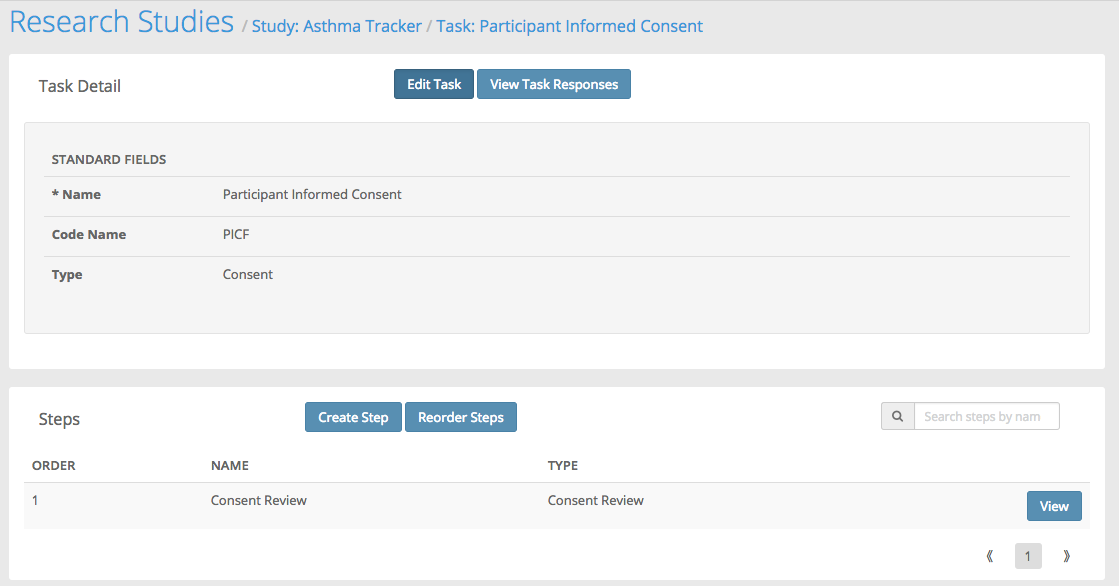
Create Consent Steps
Navigation: Axon > Studies > View Study > Consent Task > Create Step
Document Section Step Type
The following document sections come standard with Axon and include the animation built into Apple's Research Kit model. In addition to creating the standard consent sections, Medable Axon allows you to create custom document sections if the predefined consent sections above do not adequately cover the sections of your consent document.
- Overview
- Data gathering
- Privacy
- Data use
- Time commitment
- Surveys
- Tasks
- Withdrawal
- Custom Document Section
The following describes each field available to configure:
*Notes the field is required
| Field | Description | Data Format |
|---|---|---|
| Type* | Picker that allows the selection between a standard step type or Document Section step type | Value Picker (Text) |
| Section Type* | Picker that allows the selection between the pre-defined document sections or a custom section type | Value Picker (Text) |
| Title* | The title is displayed as a title in the animated consent sequence and is also included in the PDF file, but it can be overridden by setting the Formal Title. The title is pre-filled unless the type is Custom Section Type | Text |
| Summary | The summary is displayed as description text in the animated consent sequence. The summary should be limited in length, so that the consent can be reliably displayed on smaller screens | Text |
| Content | In a consent review step or in PDF file generation, the string is printed as the section’s content. The string is also displayed as Learn More content in a visual consent step. This property is never pre-populated based on the value of type. The content is not included in the legal document that is signed if a custom document is configured in the consent review step | Long Text |
| Formal Title | The formal title of the section in a localized string, for use in the legal document. If the value of this field is blank, the value of the title field is used in the legal document instead. The content is not included in the legal document that is signed if a custom document is configured in the consent review step | Text |
| HTML Content | In cases where plain text content is not sufficient to convey important details during the consent process, you can provide HTML content in this property. When you do this, the htmlContent property takes precedence over the content property. In a consent review step or in PDF file generation, the value of this field is printed as the section’s content; in a visual consent step, the content is displayed as Learn More content. The content is not included in the legal document that is signed if a custom document is configured in the consent review step | Text |
| Content URL | Used to override the ‘htmlContent’ and ‘consent’ property if a document should be required. The content is not included in the legal document that is signed if a custom document is configured in the consent review step | Text |
| Omit From Document | When set to CHECKED, the section is omitted in a consent review step or in PDF file generation | Boolean |
| Custom Image | The custom image can override the image associated with any of the predefined section types. It is ignored for a consent review step and for PDF generation. Note: The image must be an "overlay image" meaning it has to be grayscale and have transparent zones. An example image can be seen below. | Text |
| Custom Learn More Button | The predefined section types have localized descriptive Learn More button titles for a visual consent step. When this property is not blank, it overrides that default text | Text |

Consent Review Step Type
Consent Review Process
- Review Screen: Allows the user to review all of the consent and either Agree or Disagree to the consent
- Signature Typed Screen: User enters their first name and last name
- Signature Screen: User signs the consent with their finger
- PDF File is created and uploaded to Medable
The following describes each field available to configure:
*Notes the field is required
| Field | Description | Data Format |
|---|---|---|
| Type* | Picker that allows the user to choose between a Document Section or Review Section Step Type | Value Picker (Text) |
| Name* | Internal name for the step | Text |
| Reason for Consent | A user-visible description of the reason for agreeing to consent. The reason for consent is presented in the confirmation dialog that users see when giving their consent. | Long Text |
| HTML Review Consent | In more complex cases, the visual consent sections may bear little relation to the formal consent document. In a situation like this, place the formal consent document content in this filed. Doing this overrides all content that would otherwise be generated from the consent sections | Long Text |
Knowledge Check Example
User comprehension of the consent document is important in improving participation, study data, and improved outcomes in some instances. Axon allows researchers to configure a knowledge check anywhere in the consent process before the consent review step.
Challenge/Knowledge Check Setup
- Configure Document Section Steps (Assumed this is complete for this example)
- Configure the steps
- Add the branching logic
- Configure the loopback if user fails
In this example we will configure a simple consent challenge, branching, and loopback to demonstrate a valid configuration. This example assumes you have created the consent document sections already. See above for information on how to create document section steps. We will use one Yes/No question, one text choice question to validate knowledge and 2 instruction steps to control the messaging to the user on whether they passed or failed.
Add Boolean Step
- Type = Boolean
- Name = "Data Sharing Comprehension"
- Text = "We will not share your data outside of our organization"
- Leave the rest of the fields blank
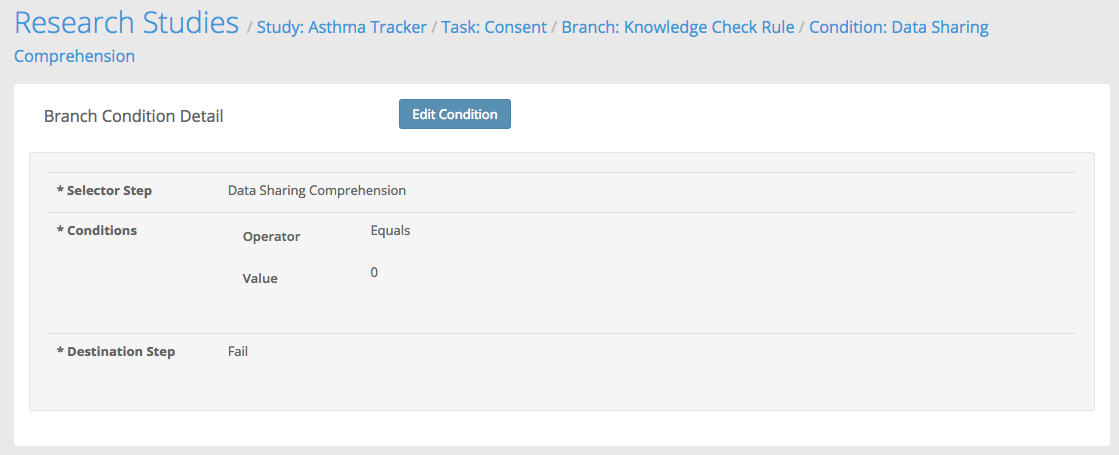
Add Text Choice Step
- Type = Text Choice
- Name = "Purpose"
- Text = "What is the purpose of this study?"
- Text Choice 1 Display Text = "Understand the effects of your disease"
- Text Choice 1 Value = 1
- Text Choice 2 = Display Text: "Treat your disease"
- Text Choice 2 Value = 2
- Leave the rest of the fields blank
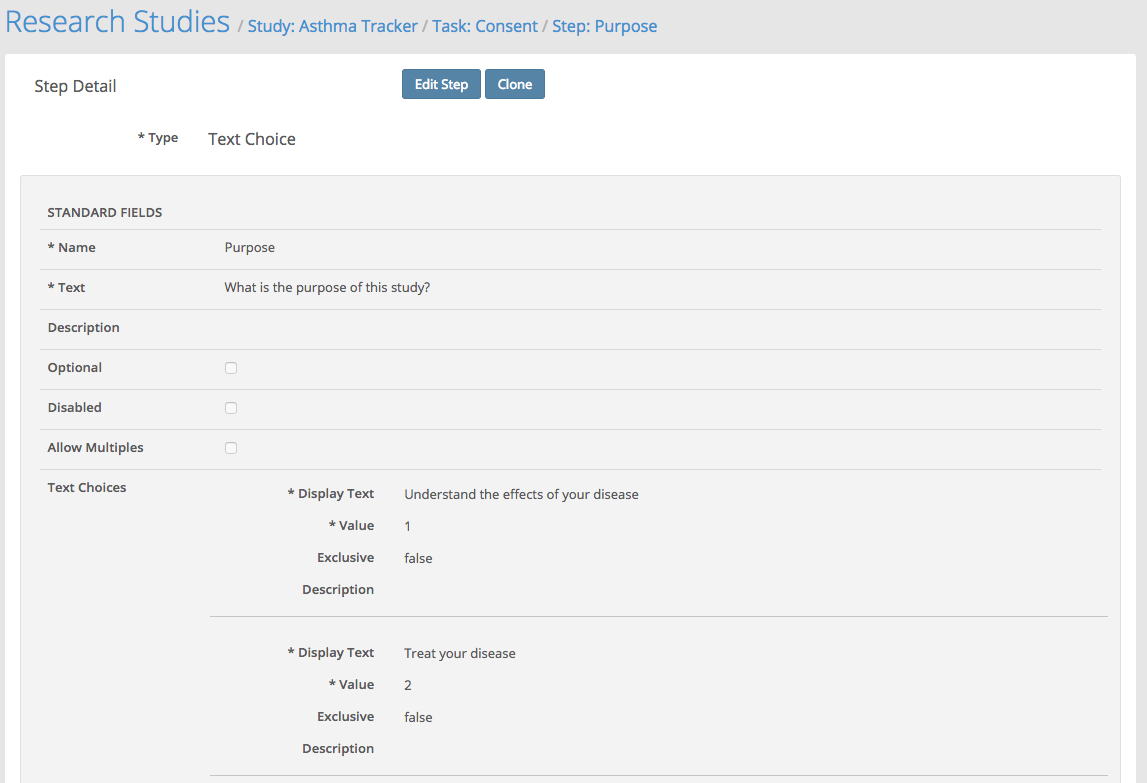
AddFail Instruction Step
- Type = Instruction
- Name = "Fail"
- Text = "Sorry you failed. Please try again."
- Leave the rest of the fields blank
AddSuccess Instruction Step
- Type = Instruction
- Name = "Success"
- Text = "Congratulations you passed! Tap next to continue."
- Leave the rest of the fields blank
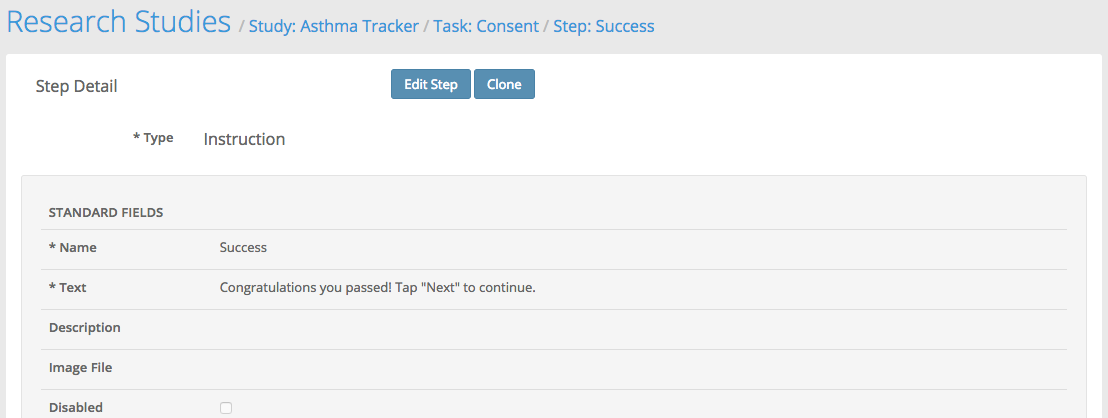
Next we will setup the two branch rules. The first branch rule will be used to determine if the user comprehended the consent. The second branch rule will be used to loopback the user to the beginning of the knowledge check if the user failed to comprehend the knowledge check.
AddBranch Rule 1 Setup
This rule will evaluate the Data Sharing Comprehension and Purpose questions configured above. Based on the answers, the rule will take the user to Success or Fail.
Navigation > Study > View Consent Task > Scroll down and click "Create Branches"
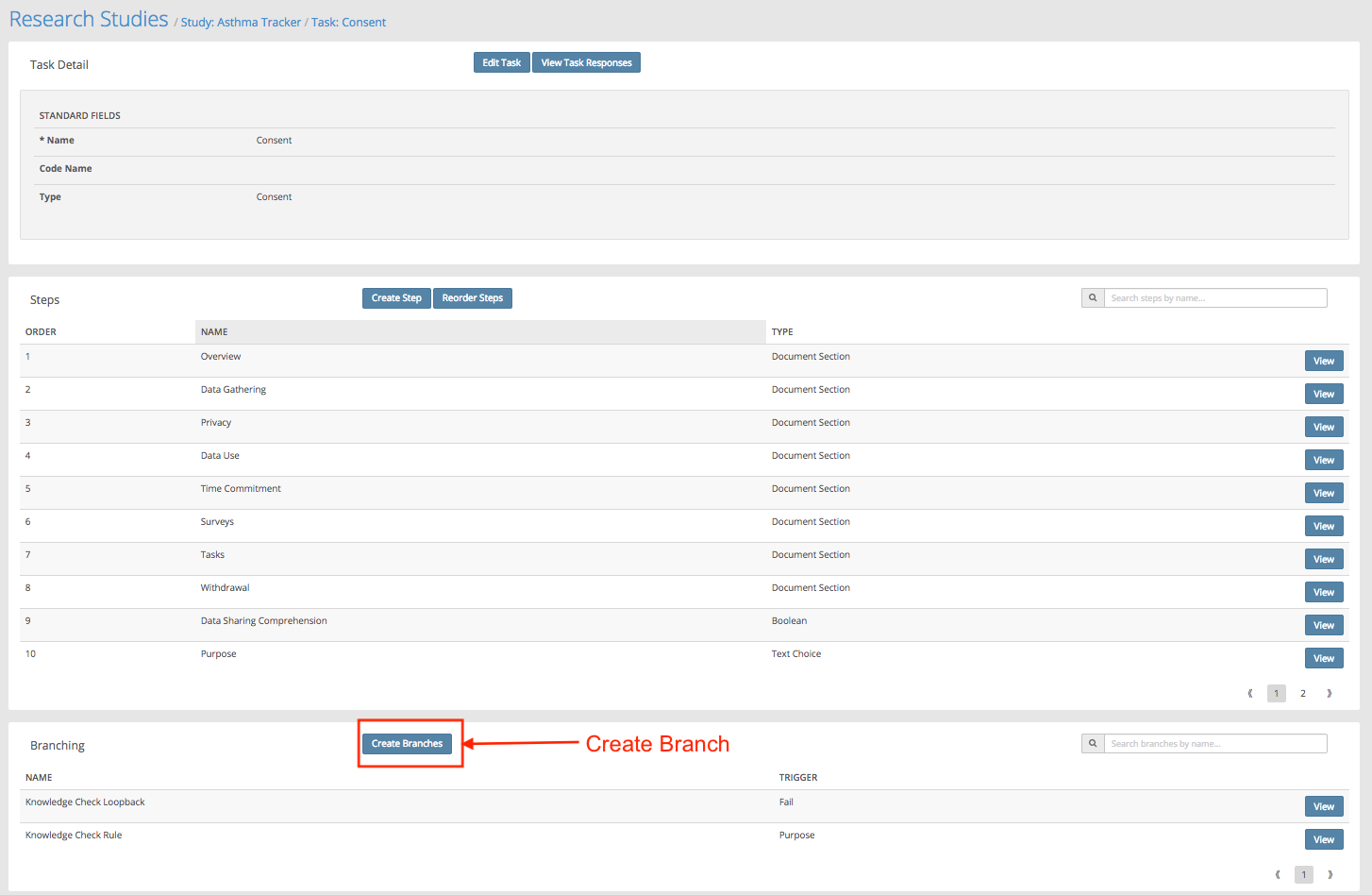
Branch Rule 1 Header
- Name = "Knowledge Check Rule"
- Trigger Step = "Purpose"
- Default Destination = "Success"
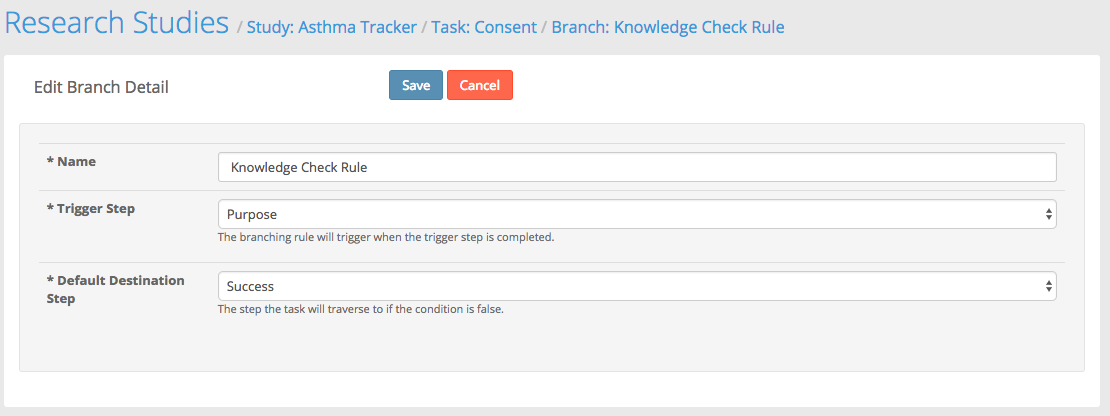
Branch Rule 1 Conditions
Create two conditions that evaluate the comprehension of the users response.
Condition 1
Navigation > Study > View Consent Task > View Knowledge Check Rule > Click Create Condition
- Selector Step = "Data Sharing Comprehension"
- Conditions = Operator: "Equals" | Value: 0
- Destination Step = "Fail"
- Hit Save
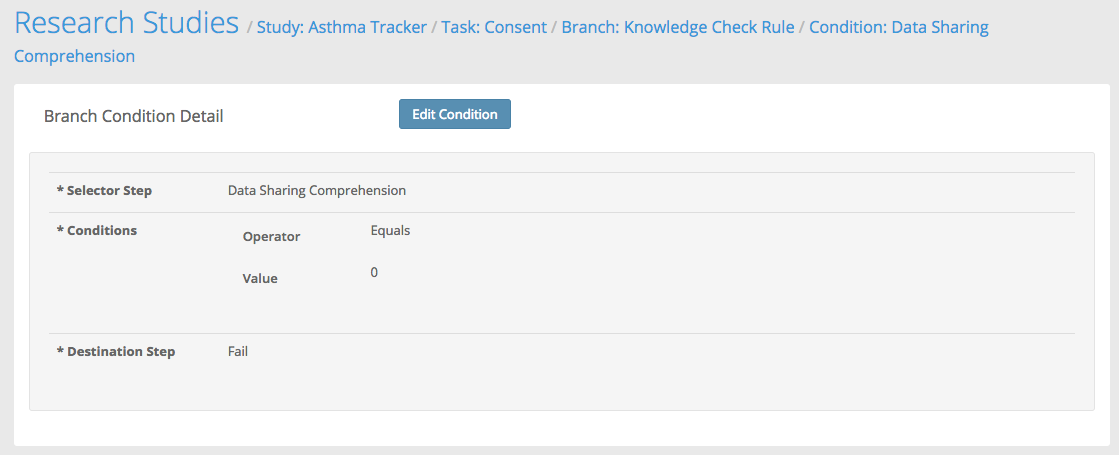
Condition 2
Navigation > Study > View Consent Task > View Knowledge Check Rule > Click Create Condition
- Selector Step = "Purpose"
- Conditions = Operator: "Equals" | Value: 2
- Destination Step = "Fail"
- Hit Save
AddBranch Rule 2 Setup
This rule will loopback the user to the beginning of the knowledge check if the user lands on the "Fail" instruction step.
Navigation > Study > View Consent Task > Scroll down and click "Create Branches"
Branch Rule 2 Header
- Name = "Knowledge Check Loopback"
- Trigger Step = "Fail"
- Default Destination = "Data Sharing Comprehension"
NOTE: There are no branch conditions for a loopback. Axon will take the user to the default destination when the user taps next on the screen.

Now you have setup a simple knowledge check at the end of a Consent. Here is what it looks like if you answer correctly.
Here is what it looks like if you answer incorrectly with the loopback.
This answer is incorrect for comprehension.
When the user taps "Next" on the screen above, the loopback takes the user back to the beginning of the knowledge check.
This is a simple example. The flexibility within consent configuration can allow you to do more complex setups and loopback including multiple challenges for lengthy consent documents.
Emailing Consent Functionality
Once consent is signed, users now have the ability to view the signed consent and email the consent to themselves. Once the user is inside of the app, the user can view the list of consents that they have signed for the study and email it to themselves if they choose to do so.
View or Email Consent
Eligibility
Medable Axon consent is based on Apple's Research Kit navigable ordered task. In a navigable ordered task, the order of the tasks can change, or branch out, depending on how the user answered a question in a previous step.
TIP: Eligibility tasks should always end on a Completion step type; configured to be either the Success Boolean being checked (Success Completion) step or Success Boolean being unchecked (Not Success Completion). Let's begin.
Eligibility Example
Eligibility Process
- Planning: Plan your eligibility process on paper. Define what it means for a user to be eligible for your study.
- Create a flow chart like below to visualize your Eligibility process
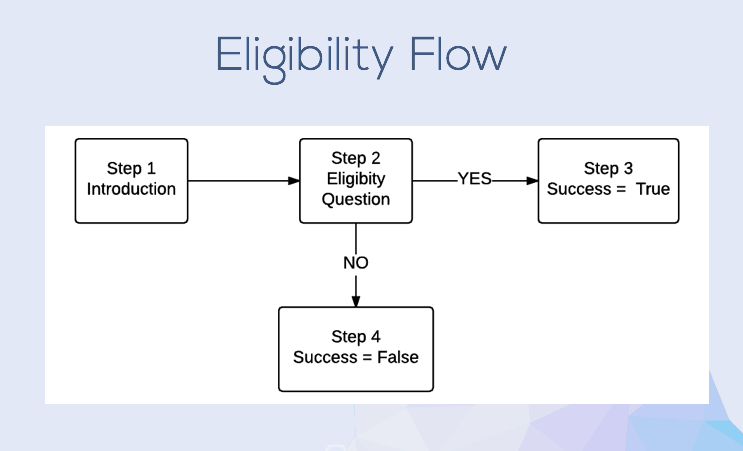
- Create Eligibility Task
- Create Steps (Link to STEPS)
-
- You must include at least 3 steps
- 2 of those steps must be a completion step
- Success
- Failure
- Create Branching Rule (Link to Create Branch Rule)
Create Eligibility Task
For purposes of this guide, we will use the above example to create the eligibility task/steps/branch rule. Steps and Branch Rules will be covered in detail later in this user guide.
Navigation: Axon > Studies > View Study > Create Task > Choose Eligibility Type
The following describes each field available to configure:
*Notes the field is required
| Field | Description | Data Format |
|---|---|---|
| Name* | Name of the Eligibility Task | Short Text |
| Code | Special internal code you can give to your task. It may reference an external system or an IRB Application number | Short Text |
| Description | Description of your task | Long Text |
Create Eligibility Steps
Navigation: Axon > Studies > View Study > View Eligibility Task > Create Step
The following step types will be used to create our eligibility flow
- Instruction Step
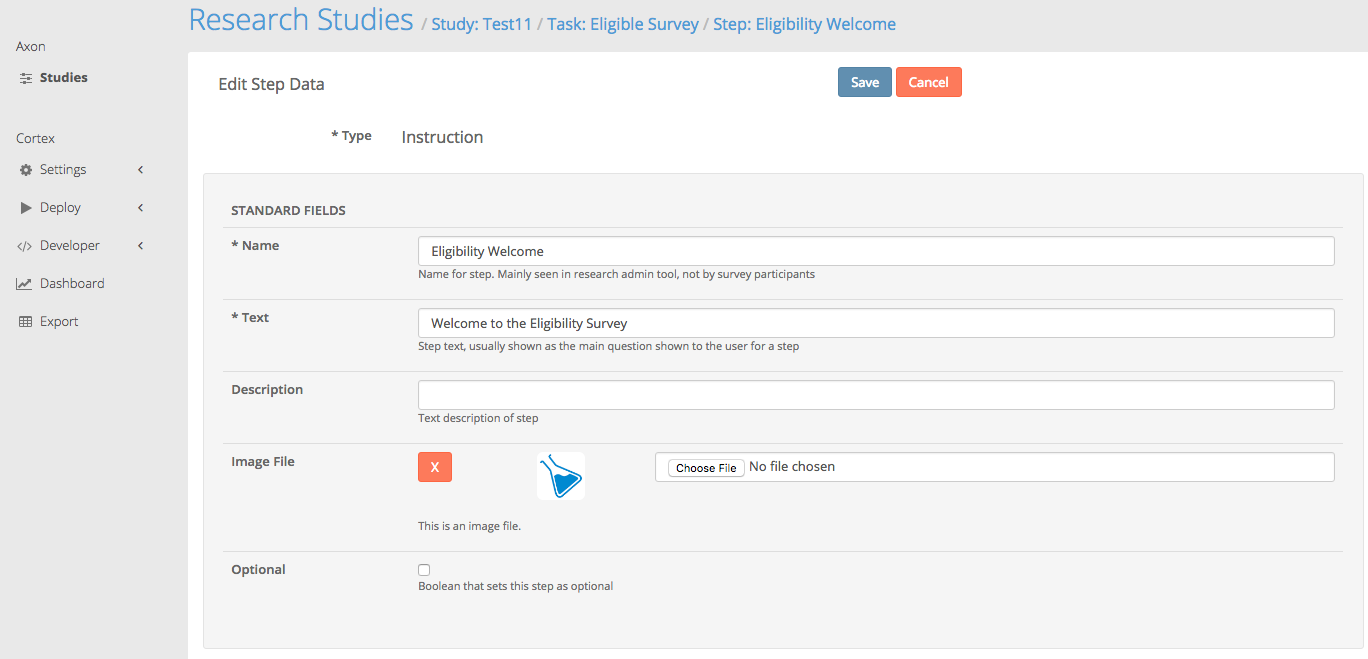
- Boolean Step
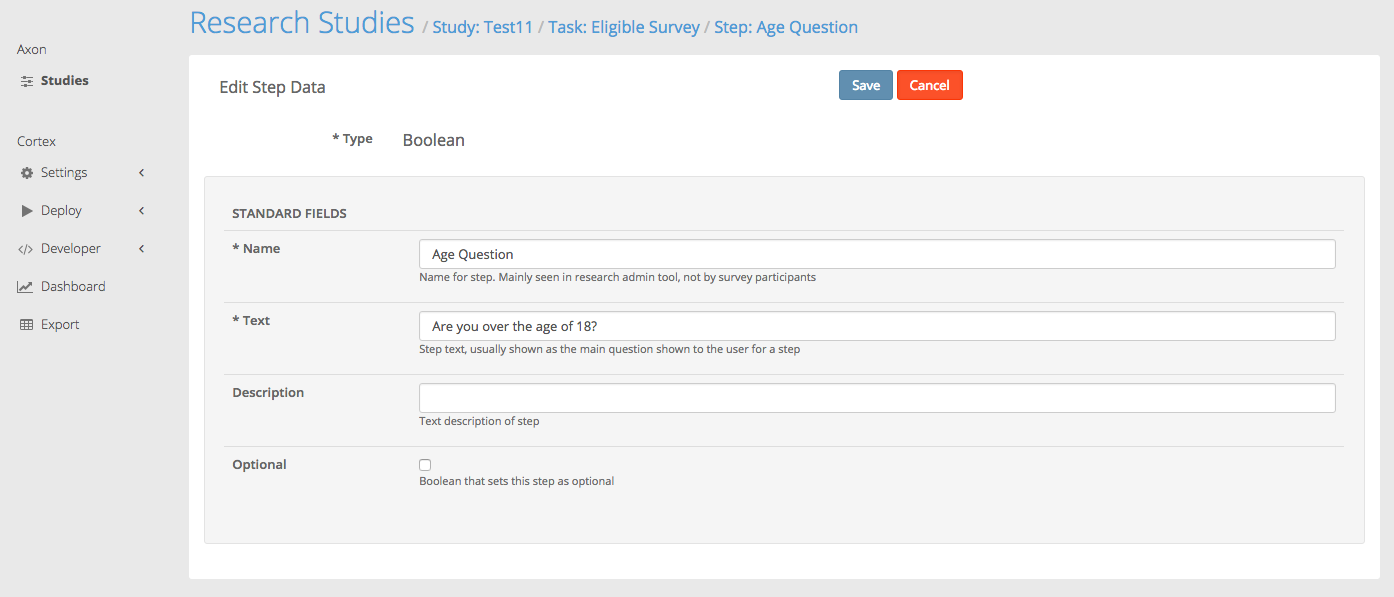
- Completion Step – Success
NOTE: The Success checkbox is Checked
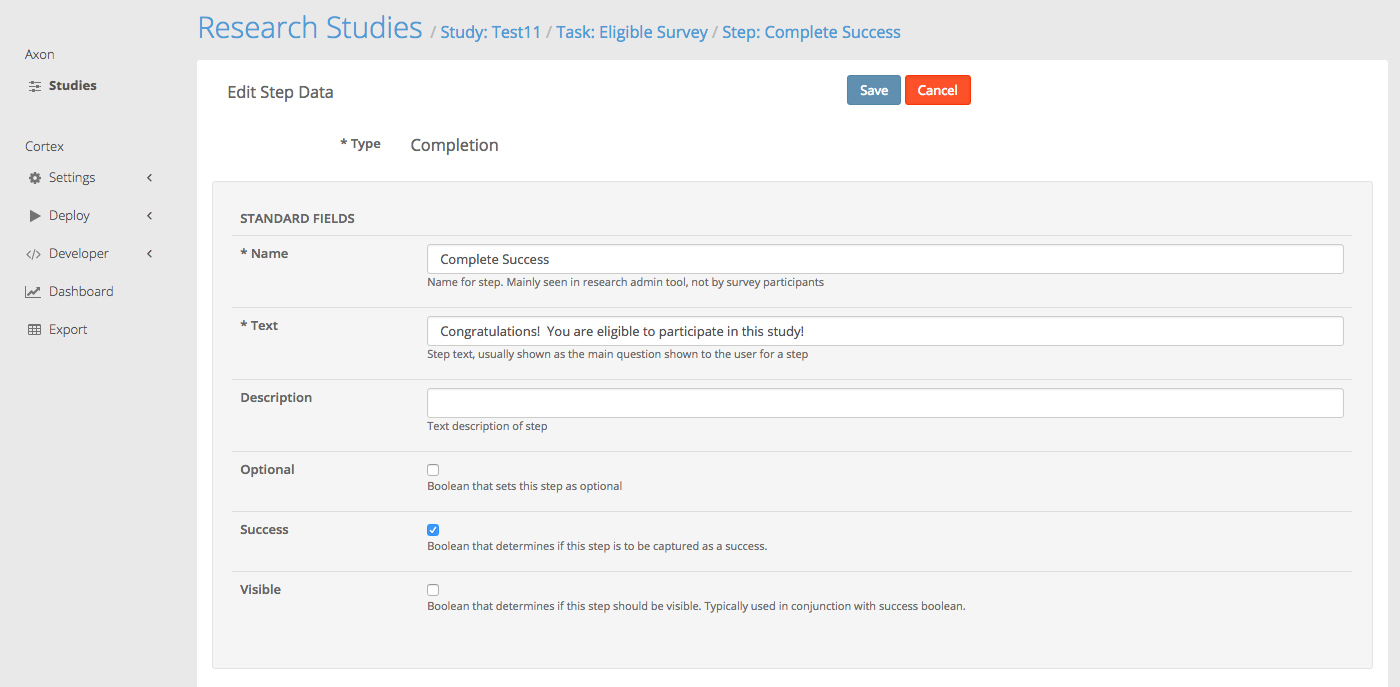
- Completion Step – Fail
NOTE: The Success checkbox is not checked
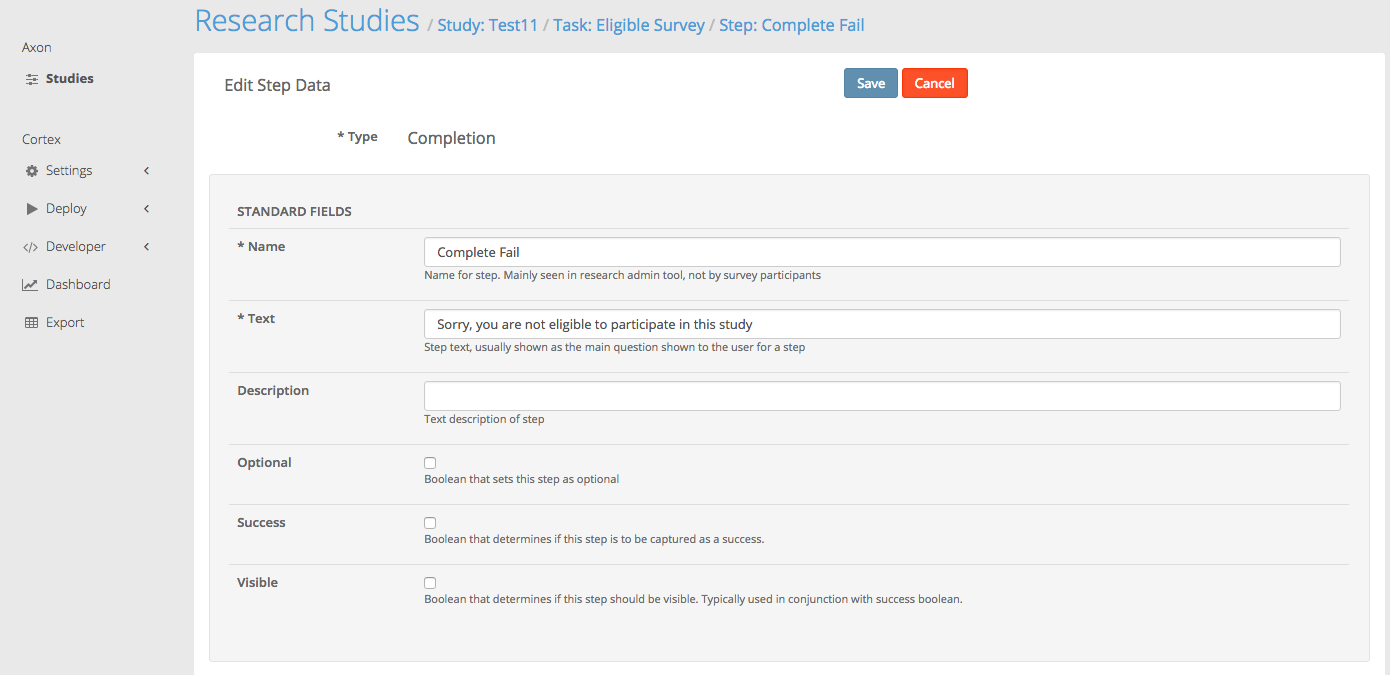
Create Branch Rule
Navigation: Axon > Studies > View Study > View Eligibility Task > Create Branches
The following branch rule will be used to create our eligibility flow
- Branch Rule Header
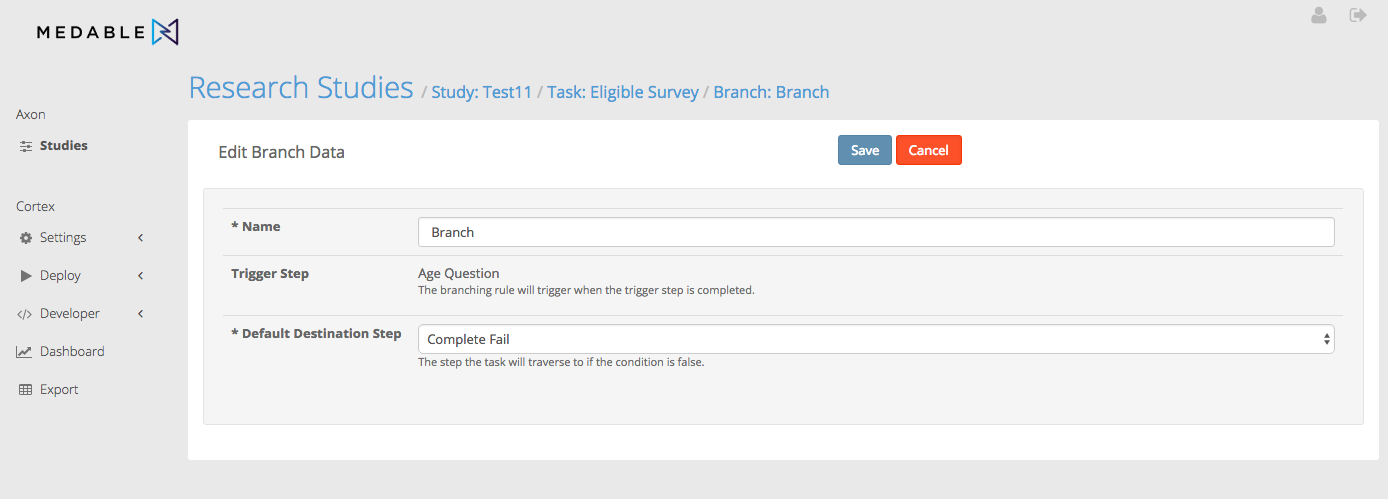
- Branch Rule Condition
Navigation: Axon > Studies > View Study > View Eligibility Task > View Branch Rule > Create Condition
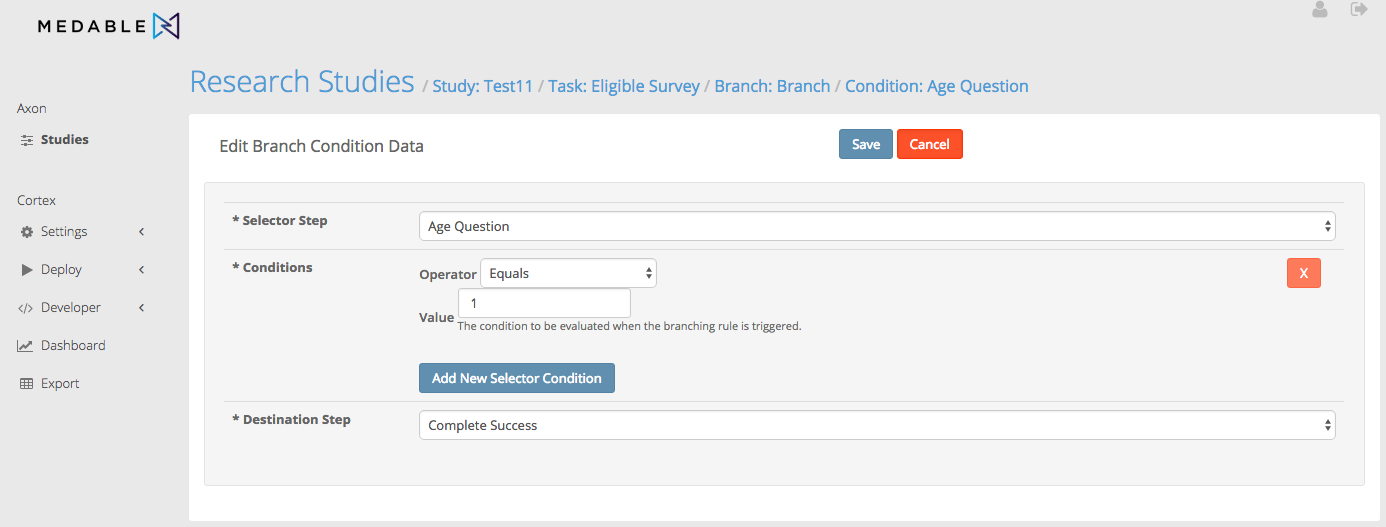
Survey
A survey is composed of a sequence of questions that you use to collect data from your users. To start a survey, you create a survey task, which is a collection of steps. Each step handles a specific question in the survey, such as "What medications are you taking?" or "How many hours did you sleep last night?" Let's begin
TIP: All Survey Tasks must end in a Completion Step to notify the app that the task is complete.
Navigation: Axon > Studies > View Study > Create Task > Choose Survey Type
The following describes each field available to configure:
*Notes the field is required
| Field | Description | Data Format |
|---|---|---|
| Name* | Name of the Survey Task | Short Text |
| Code | Special internal code you can give to your task. It may reference an external system or an IRB Application number | Short Text |
| Description | Description of your task | Long Text |
Authentication
Medable Axon provides an easy to use task for registering users for your study. The task will automatically create a Form Step and the necessary fields to successfully create a participant user in Medable for your study. Let's begin.
Create Authentication Task
Navigation: Axon > Studies > View Study > Create Task > Choose Authentication Type
The following describes each field available to configure:
*Notes the field is required
| Field | Description | Data Format |
|---|---|---|
| Name* | Name of the Authentication Form | Short Text |
| Code | Special internal code you can give to your task. It may reference an external system or an IRB Application number | Short Text |
| Description | Description of your task | Long Text |
Axon will automatically create the Form step with the following steps to capture the fields necessary for a Medable Axon user account. Each step is mapped to a corresponding Account property within Medable.
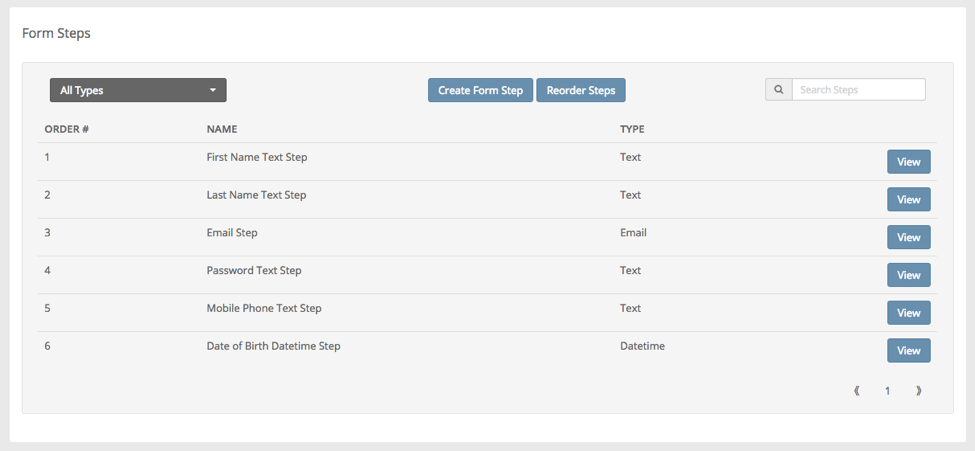
Advanced Authentication Features
What if you wanted to capture more information on registration? You can do that with a few easy steps. Let's Begin.
- Create the Properties on the Account object that you want to capture. You can find a tutorial in the Medable Cortex documentation.
- Create the additional form steps that you want to capture and assign the mapping field to the Account Property.
TipThe Account Mapping field only exists on Steps and Form Steps where the parent task is of type Authentication.
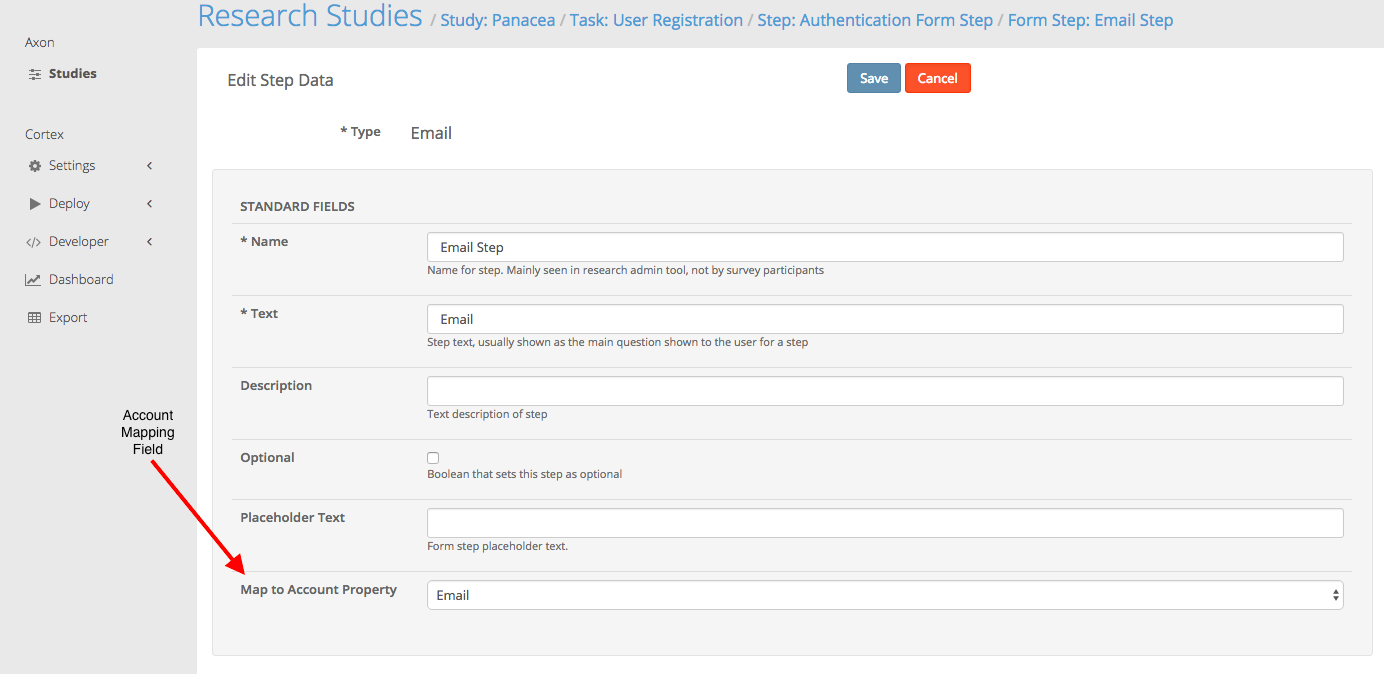
- No need to add a completion step for an Authentication Task, just hit save and test. Upon registration, Medable Axon will store the information gathered on the user Account.
Active Tasks
Some studies may need more data than is provided by responses to survey questions or the data collection capabilities of the HealthKit and CoreMotion APIs on iOS. Active tasks invite users to perform activities under partially controlled conditions using iPhone sensors to actively collect data. For example, an active task for analyzing gait and balance might asks the user to walk a short distance, while collecting accelerometer data on the device. Axon supports the following Active Tasks:
Audio
In the audio task, the user makes a sustained sound, and an audio recording is made. Analysis of the audio data is not included in the ResearchKit framework, but might naturally involve looking at the power spectrum and how it relates to the ability to produce certain sounds. The ResearchKit framework uses the AVFoundation framework to collect this data and to present volume indication during recording. No data analysis is done by ResearchKit; you can define your analysis on this task according to your own requirements.
Create Audio Task
Navigation: Axon > Studies > View Study > Create Task > Choose Predefined Active Task > Choose Audio
The following describes each field available to configure:
*Notes the field is required
Field | Description | Data Format |
|---|---|---|
Name * | Name of the Audio Task | Short Text |
Code Name | Special internal code you can give to your task. It may reference an external system or an IRB Application number | Short Text |
Description | Description of your task | Long Text |
Intended Use | Instructional content describing the intended use of the data collected. If left blank, default localized text is used. | Short Text |
Speech Instruction | Instructional content describing what the user needs to do when recording begins. If left blank, the default localized text is used | Short Text |
Short Speech Instruction | Instructional content shown during audio recording. If left blank, the default localized text is used | Short Text |
Duration * | The amount of seconds the count down timer runs for while audio data is collected. Minimum 5 seconds | Number |
Record Setting * |
| Short Text |
The screenshots below show an example of an audio task.
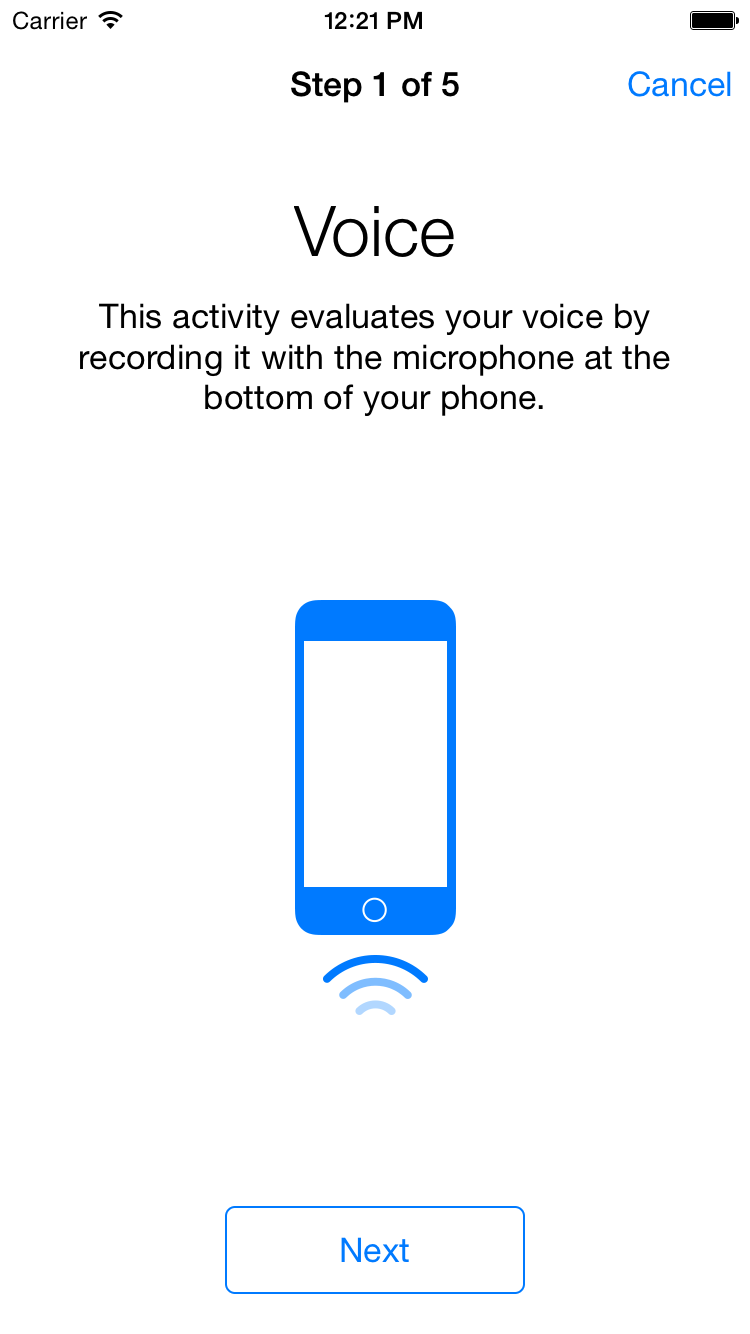
Instruction Step
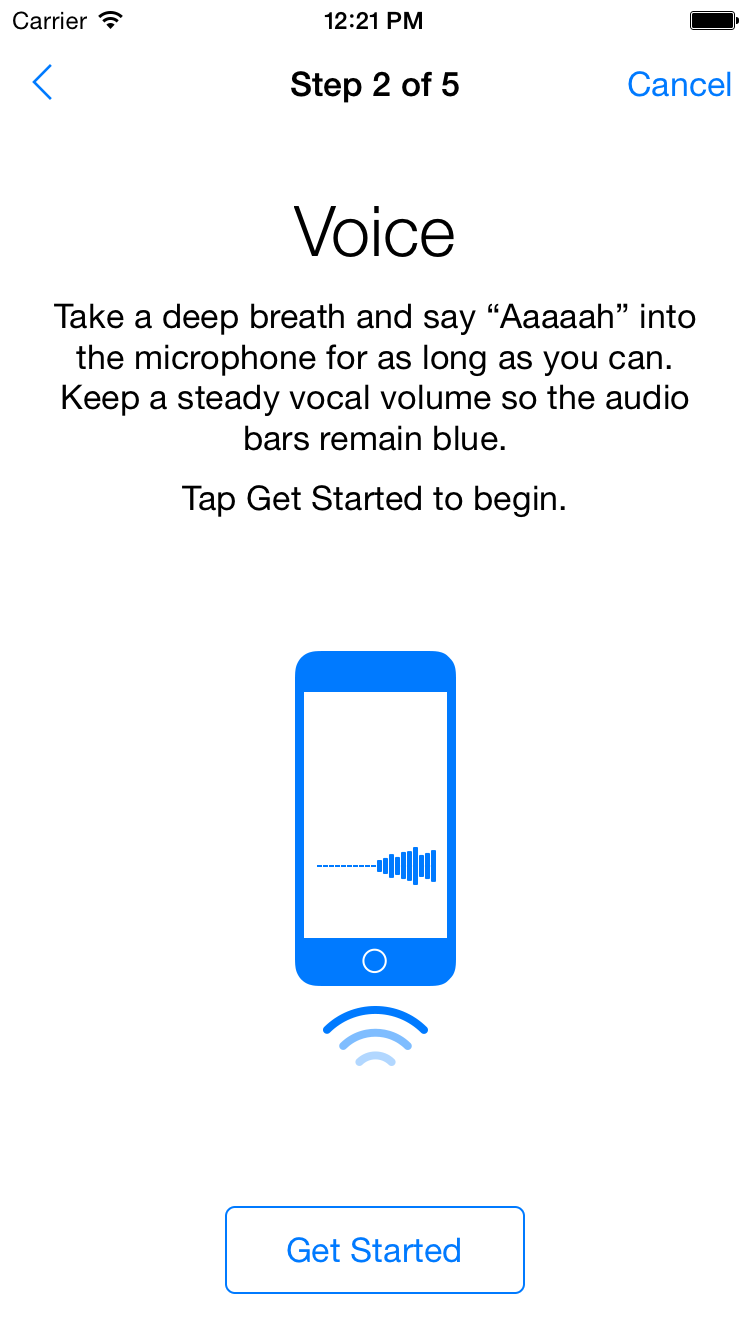
Instruction Step
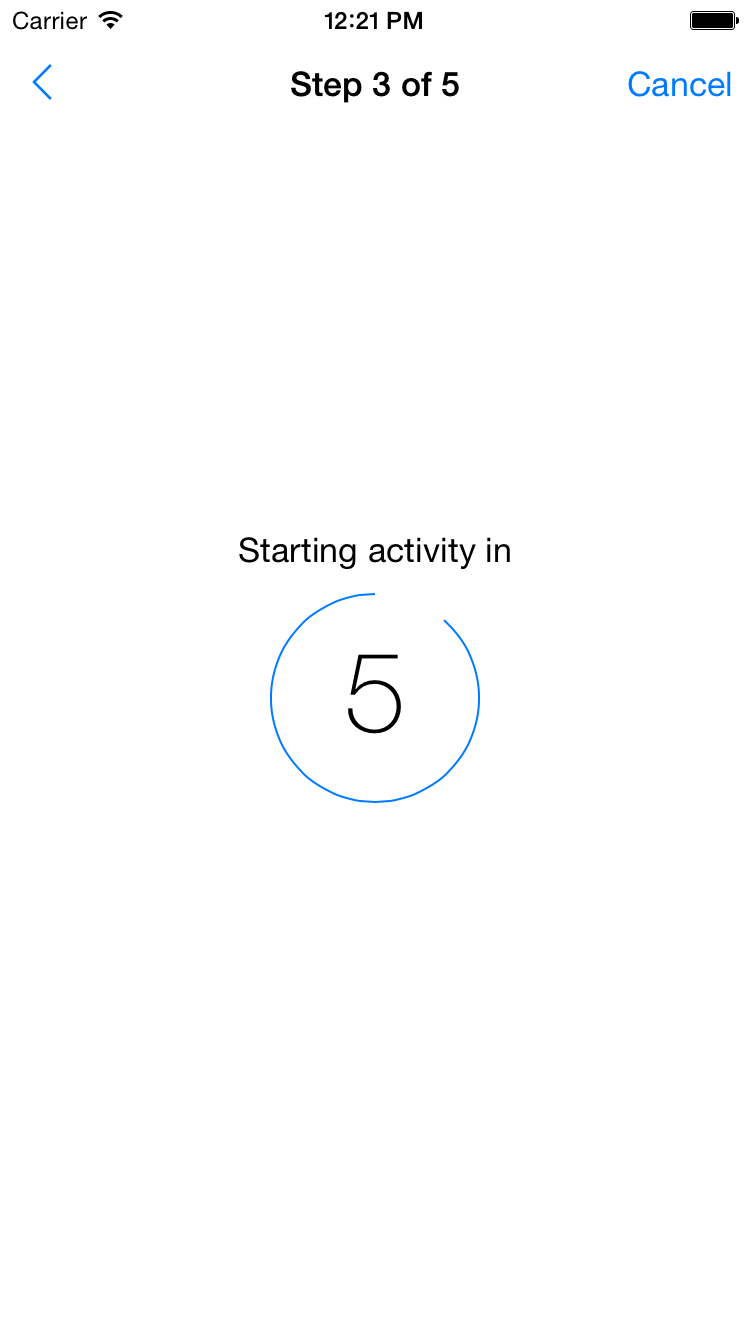
Count Down
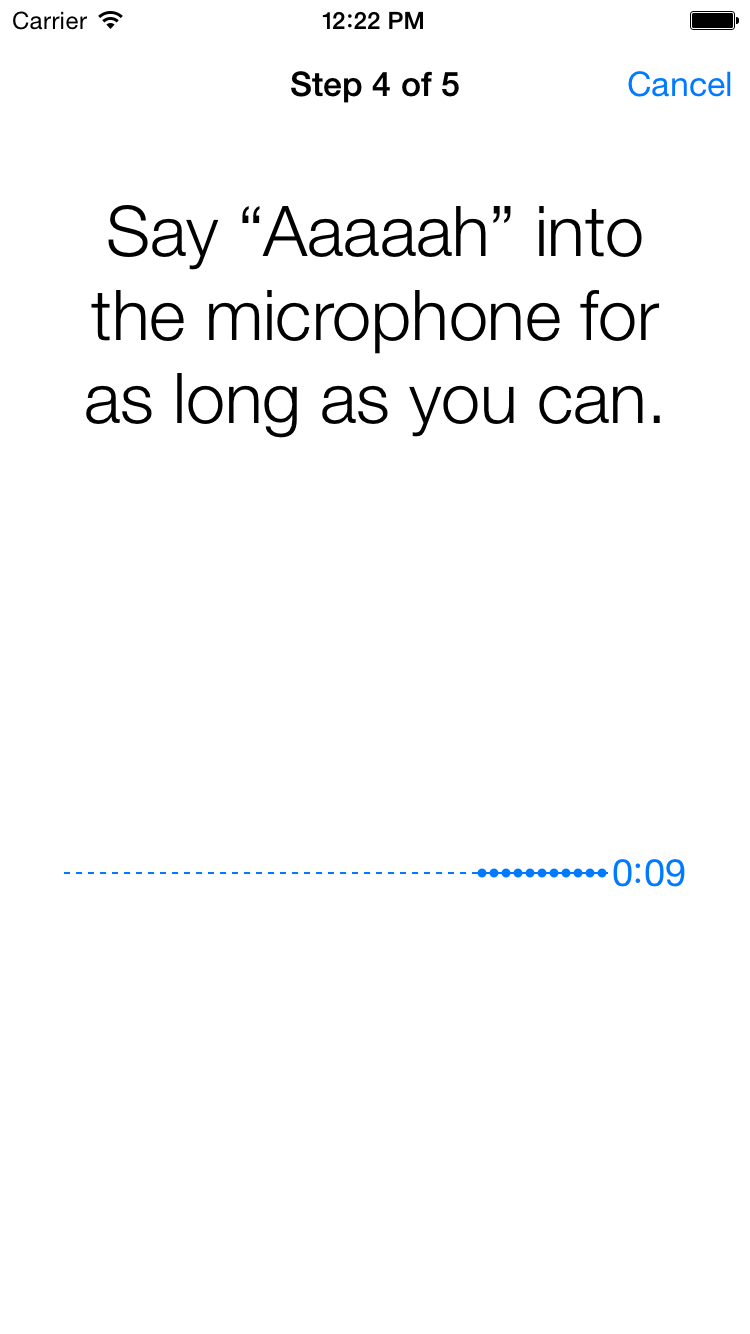
Audio Collection Step
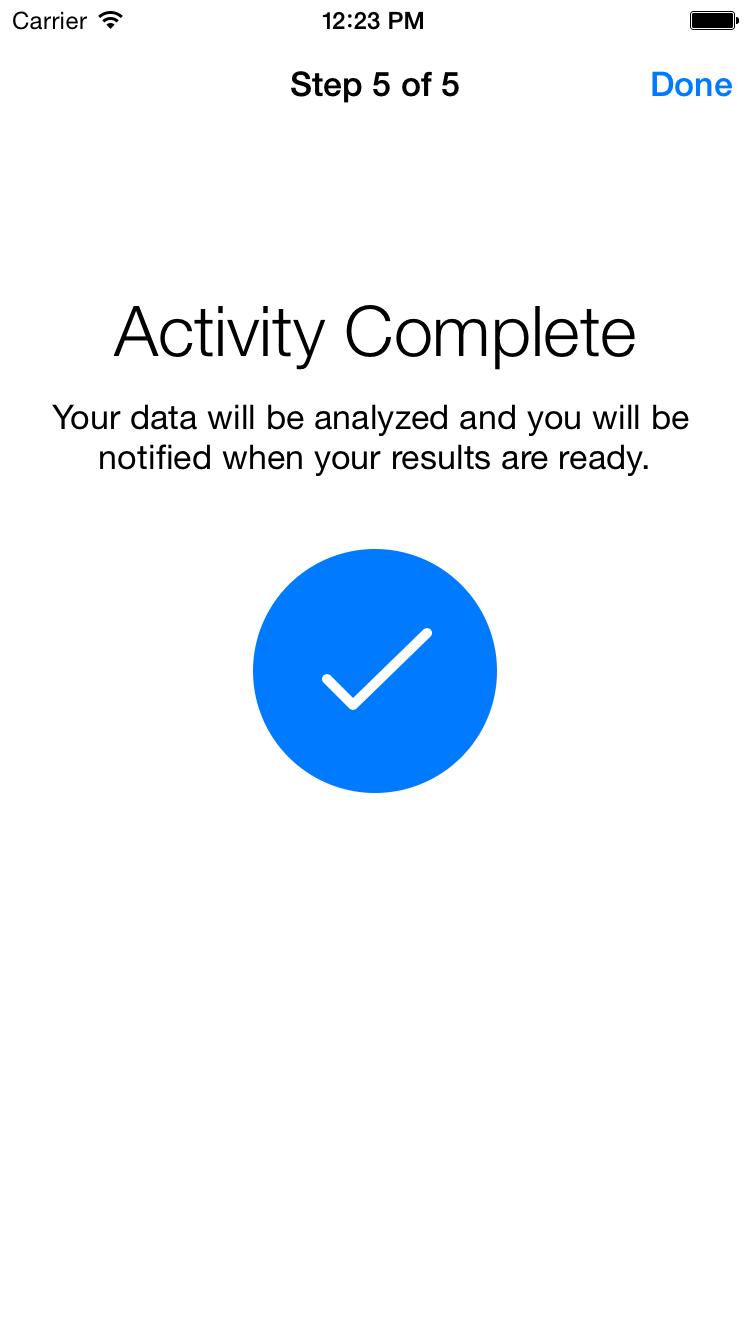
Completion Step
Fitness Check
In the fitness task, the user walks for a specified duration (usually several minutes). Sensor data is collected and returned. Sensor data can include accelerometer, device motion, pedometer, location, and heart rate data where available.
Toward the end of the walk, if heart rate data is available, the user is asked to sit down and rest for a period. Data collection continues during the rest period.
Create Fitness Check Task
Navigation: Axon > Studies > View Study > Create Task > Choose Predefined Active Task > Choose Fitness Check
The following describes each field available to configure:
*Notes the field is required
| Field | Description | Data Format |
|---|---|---|
| Name* | Name of the Fitness Check Task | Short Text |
| Code Name | Special internal code you can give to your task. It may reference an external system or an IRB Application number | Short Text |
| Description | Description of your task | Long Text |
| Intended Use | Instructional content describing the intended use of the data collected. If left blank, default localized text is used. | Short Text |
| Walk Duration* | The duration of the walk in seconds. Maximum is 600 seconds | Number |
| Rest Duration* | The duration of the post walk rest period in seconds | Number |
The screenshots below show how a fitness task might look.
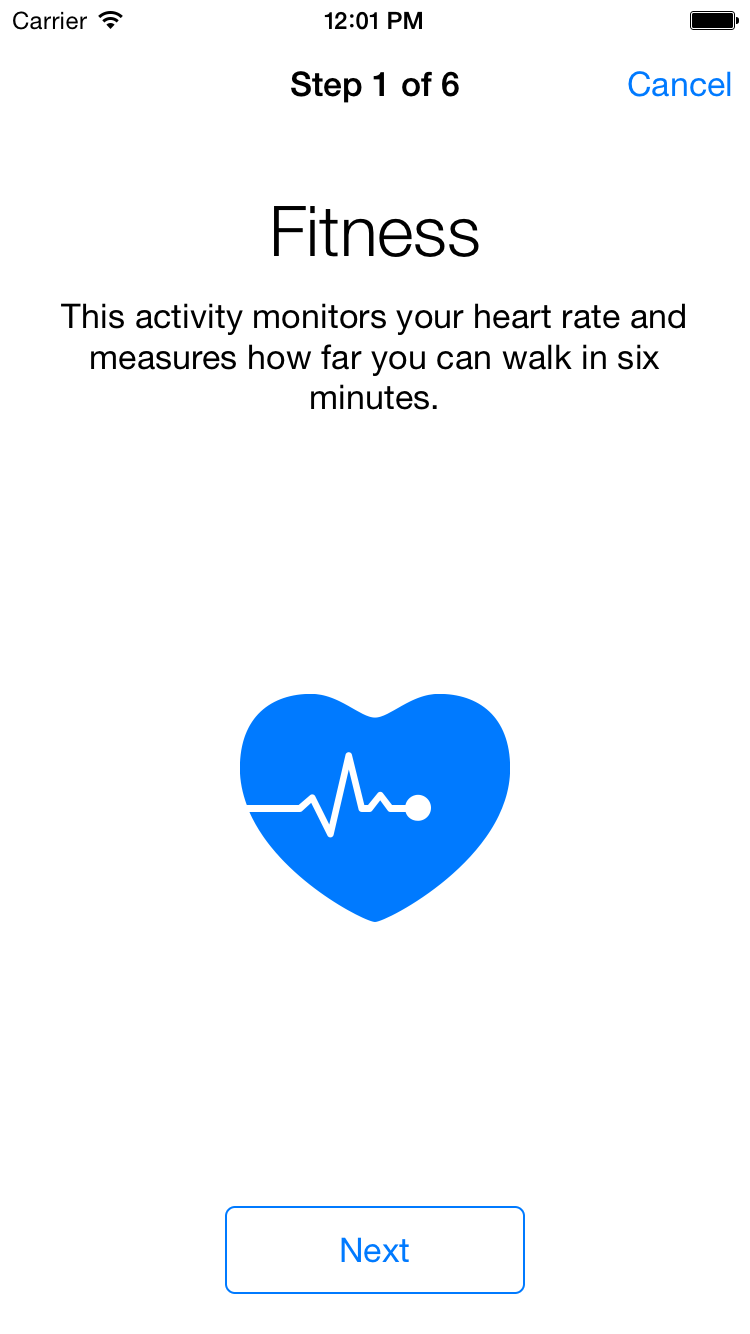
Instruction Step
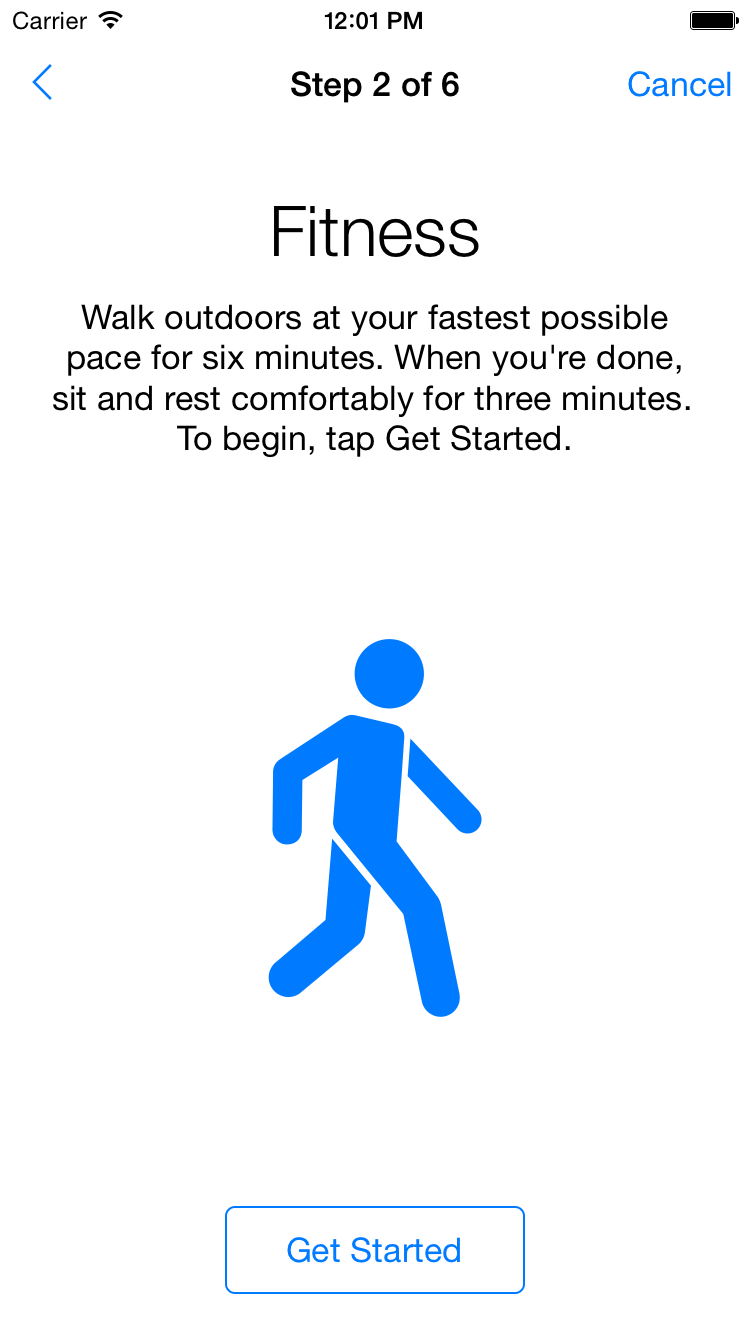
Instruction Step
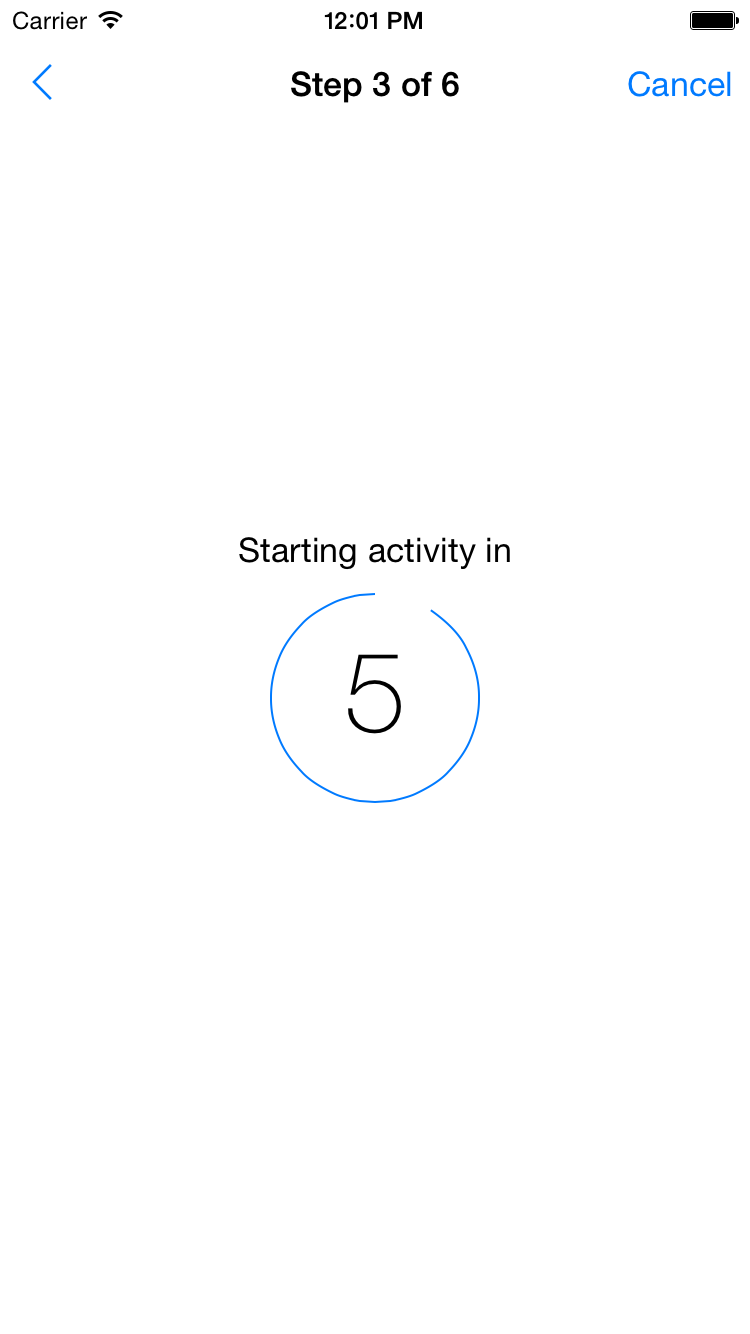
Count Down
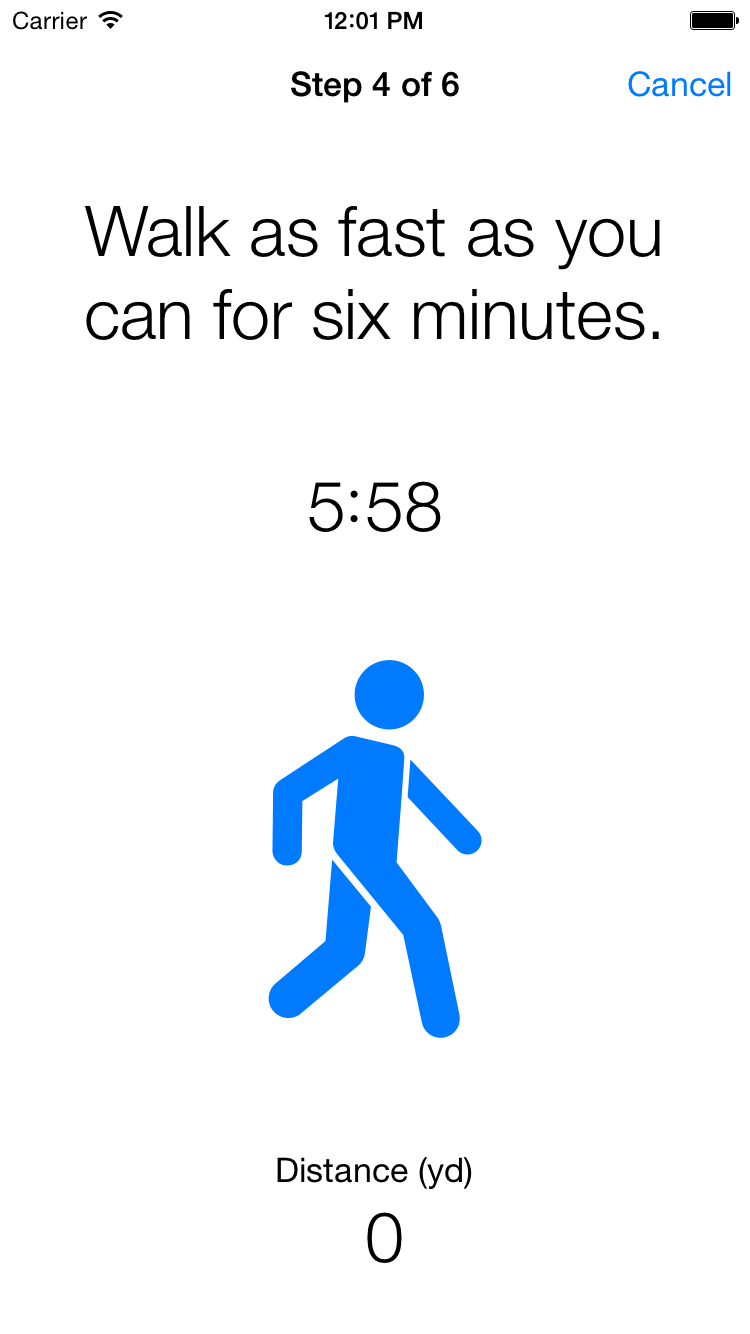
Distance and Heart Rate Collection Step
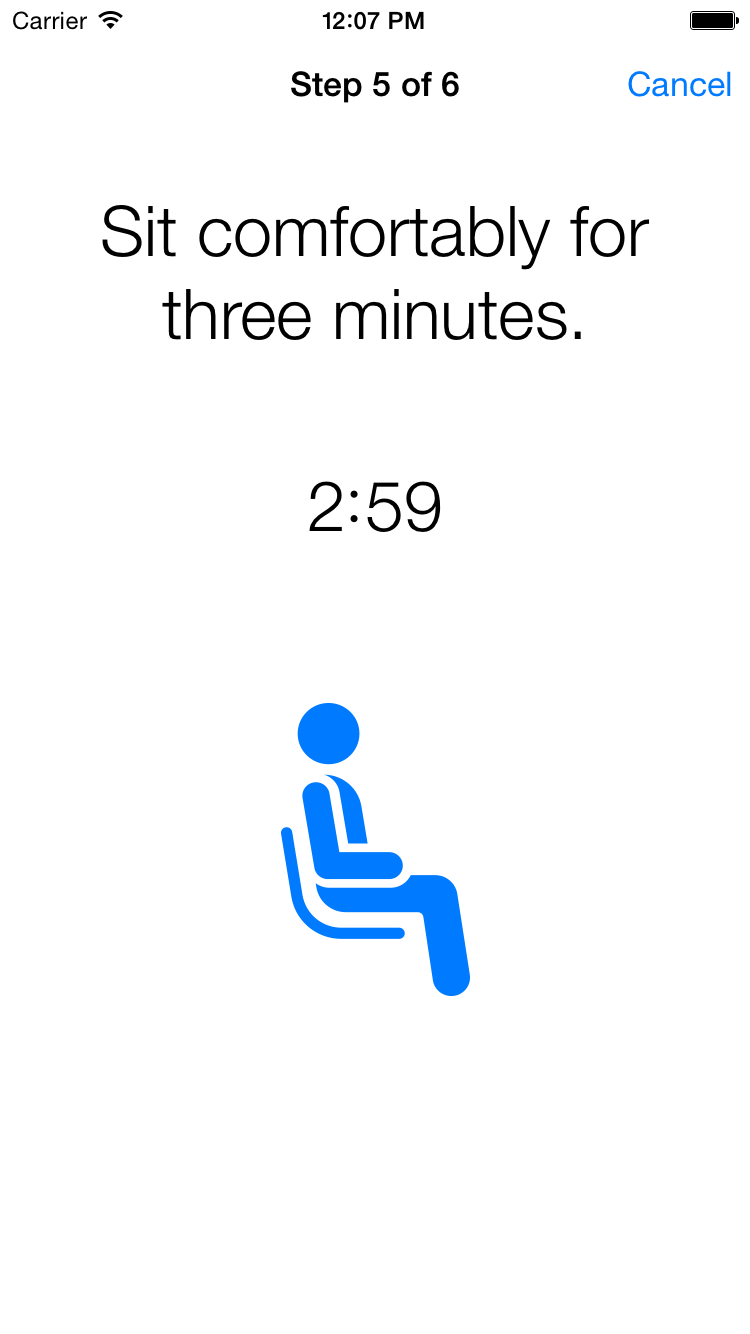
Rest Step
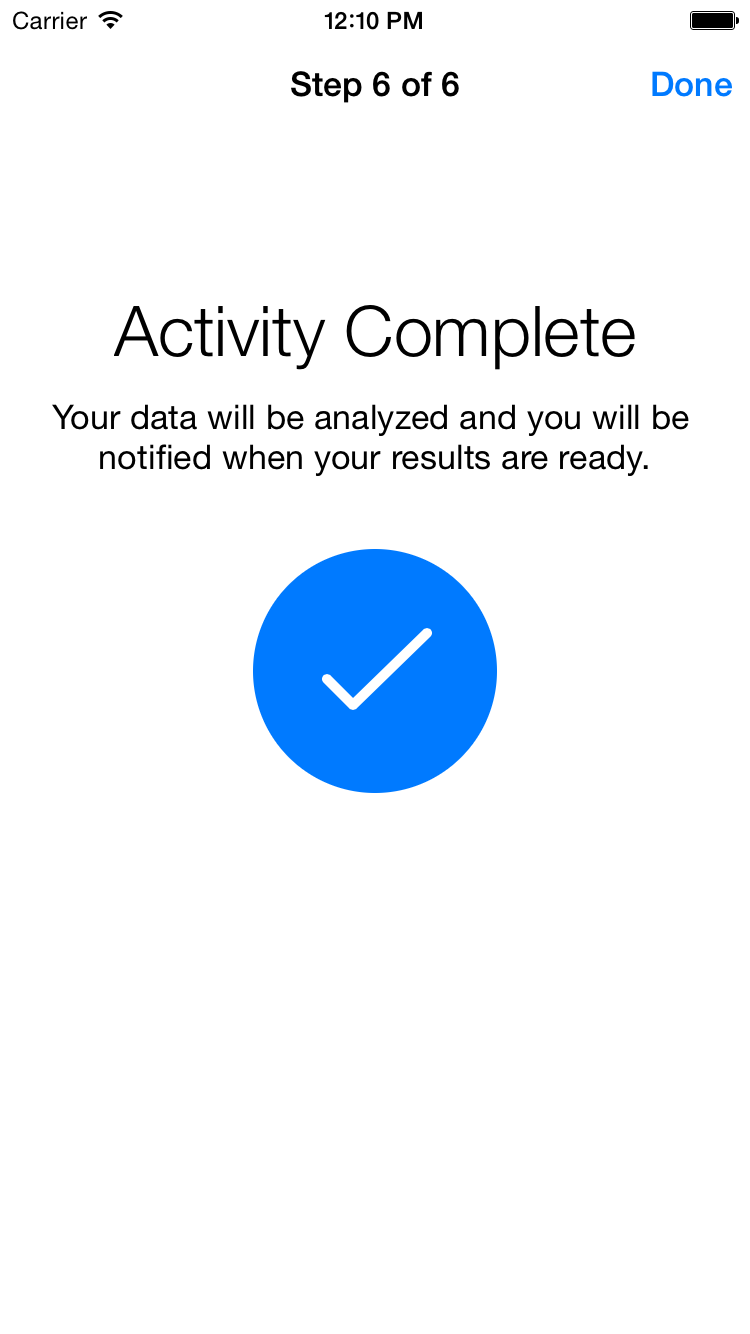
Completion Step
Short Walk
In the short walk task (also known as a gait and balance task), the user walks for a short distance, which may be indoors. You might use this semi-controlled task to collect objective measurements that can be used to estimate stride length, smoothness, sway, and other aspects of the participant’s walking.
The presentation of the short walk task differs from the fitness check task in that the distance is replaced by the number of steps taken, and the walk is split into a series of legs. After each leg, the user is asked to turn and reverse direction.
The data collected by this task can include accelerometer, device motion, and pedometer data.
Create Short Walk Task
Navigation: Axon > Studies > View Study > Create Task > Choose Predefined Active Task > Choose Fitness Check
*Notes the field is required
| Field | Description | Data Format |
|---|---|---|
| Name* | Name of the Short Walk Task | Short Text |
| Code Name | Special internal code you can give to your task. It may reference an external system or an IRB Application number | Short Text |
| Description | Description of your task | Long Text |
| Intended Use | Instructional content describing the intended use of the data collected. If left blank, default localized text is used. | Short Text |
| Number of Steps Per Leg* | The number of steps the participant is asked to walk. If the pedometer is unavailable, a distance is suggested and a suitable count down timer is displayed for each leg of the walk. | Number |
| Rest Duration* | The duration of the post walk rest period in seconds | Number |
The screenshots below show an example of a short walk task.
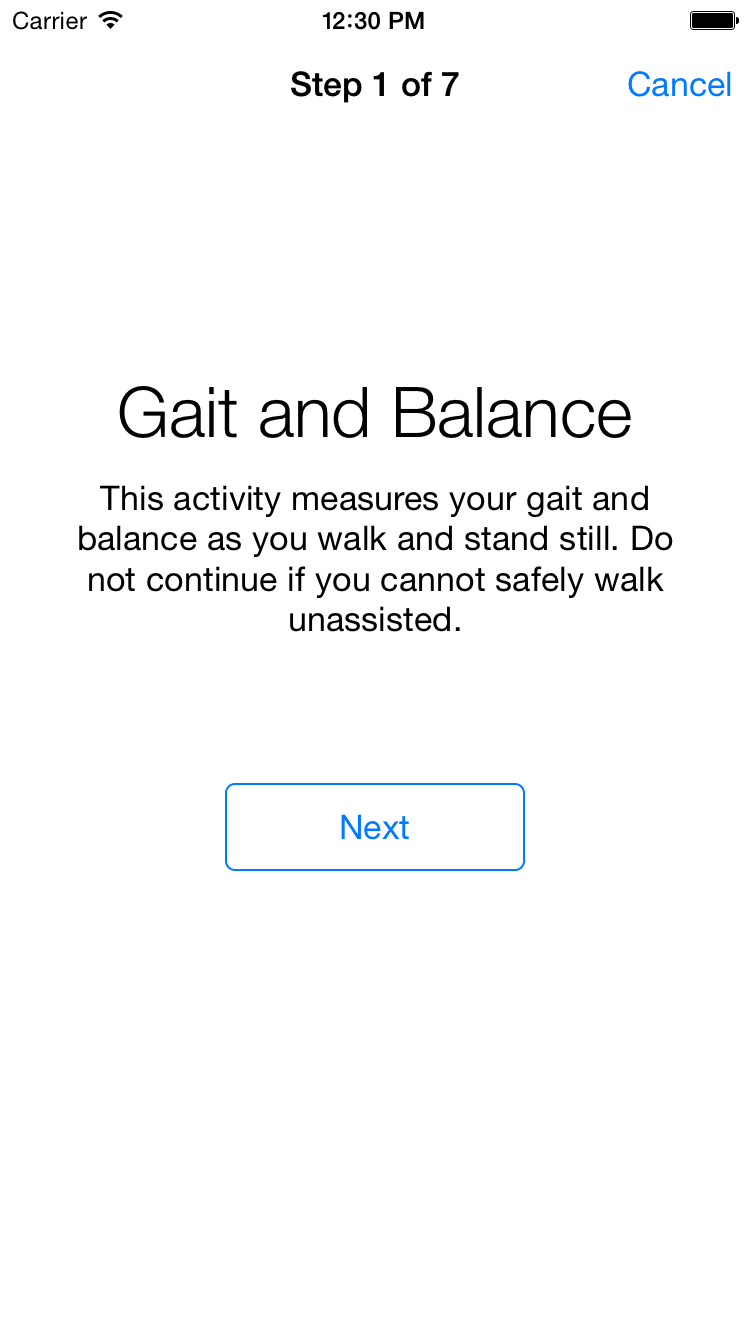
Instruction Step
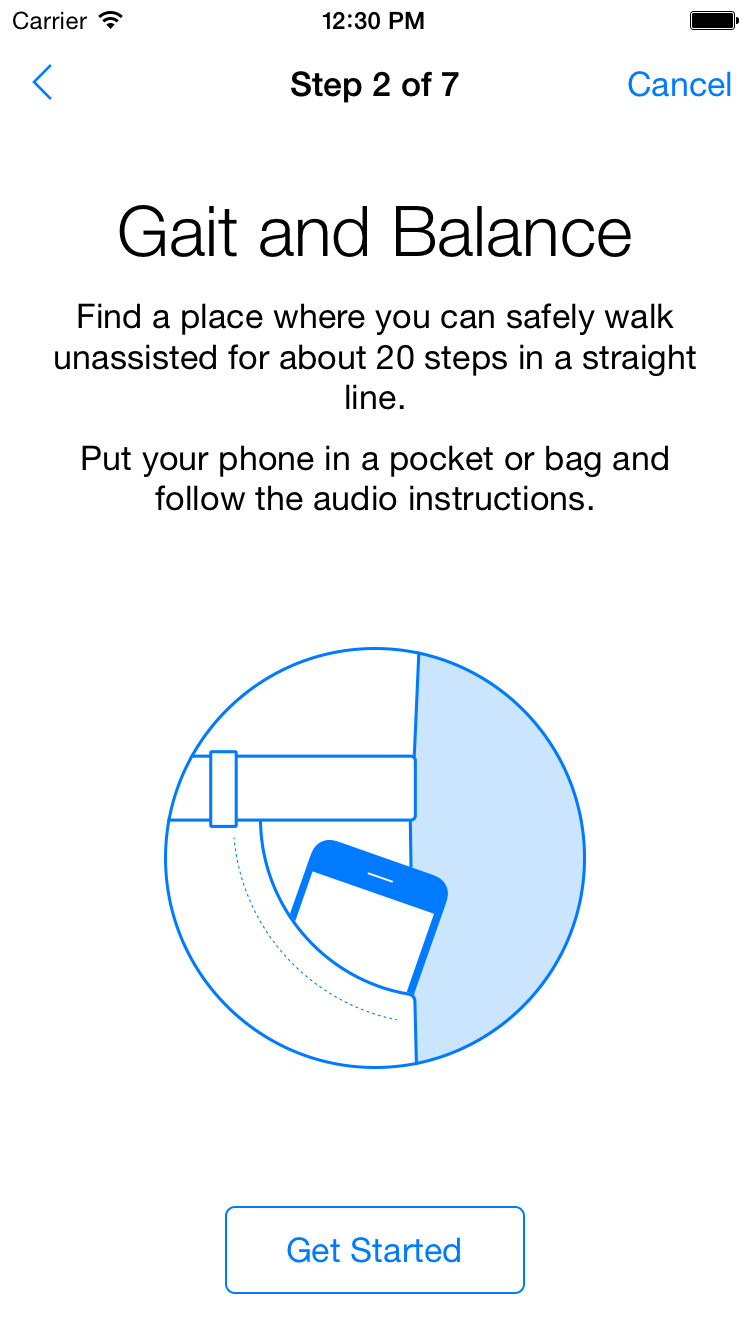
Instruction Step
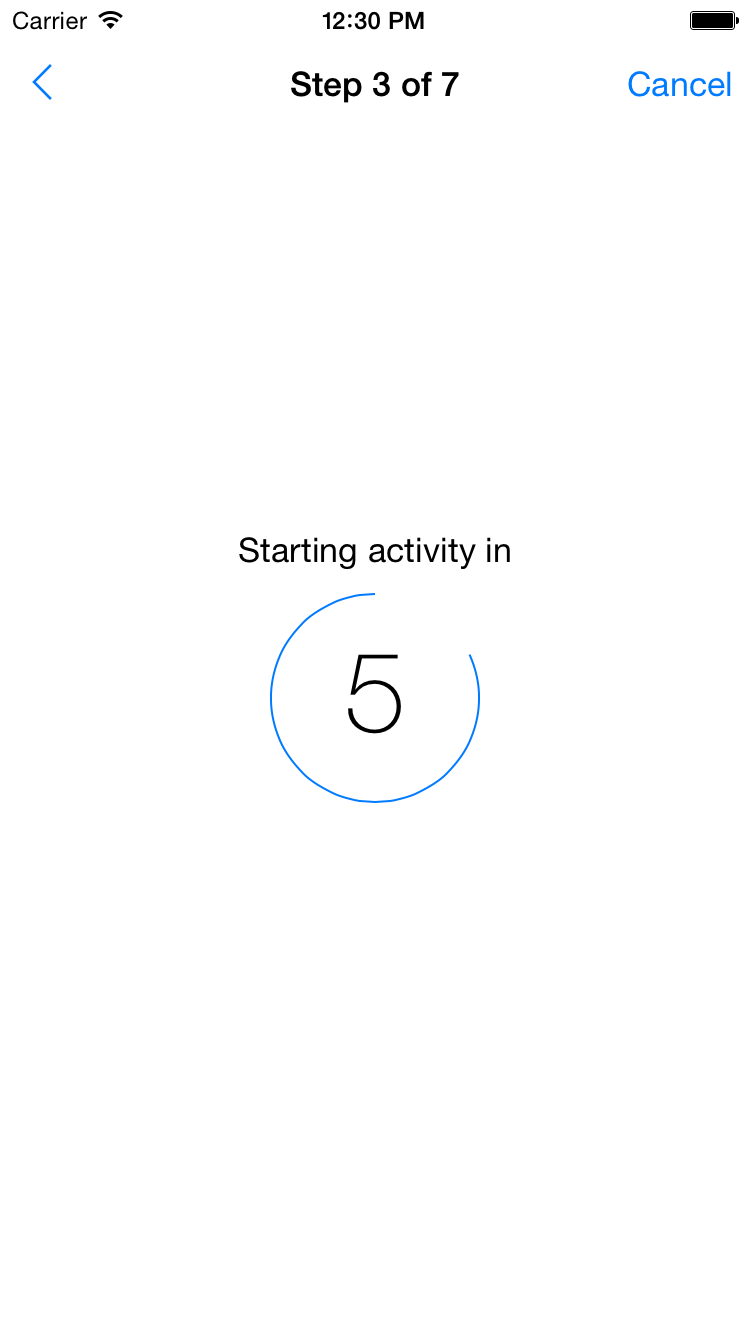
Countdown
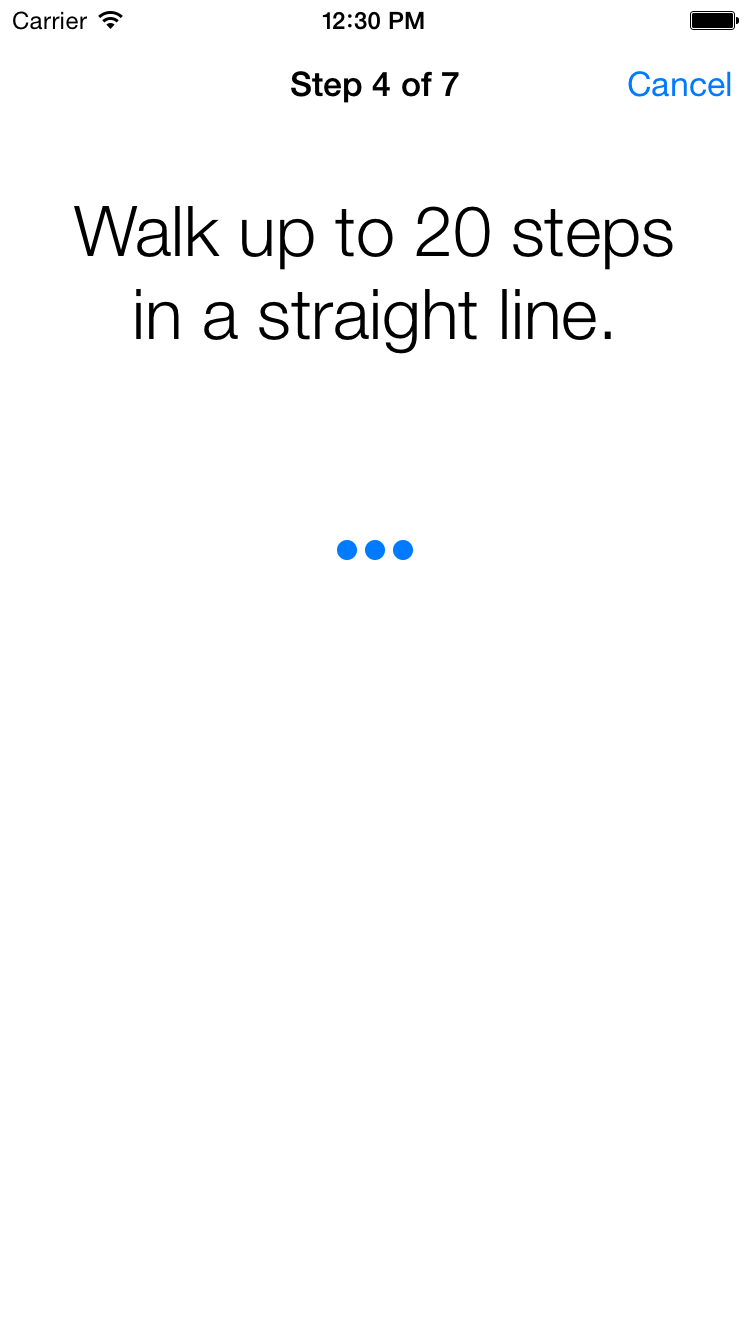
Asking user to walk
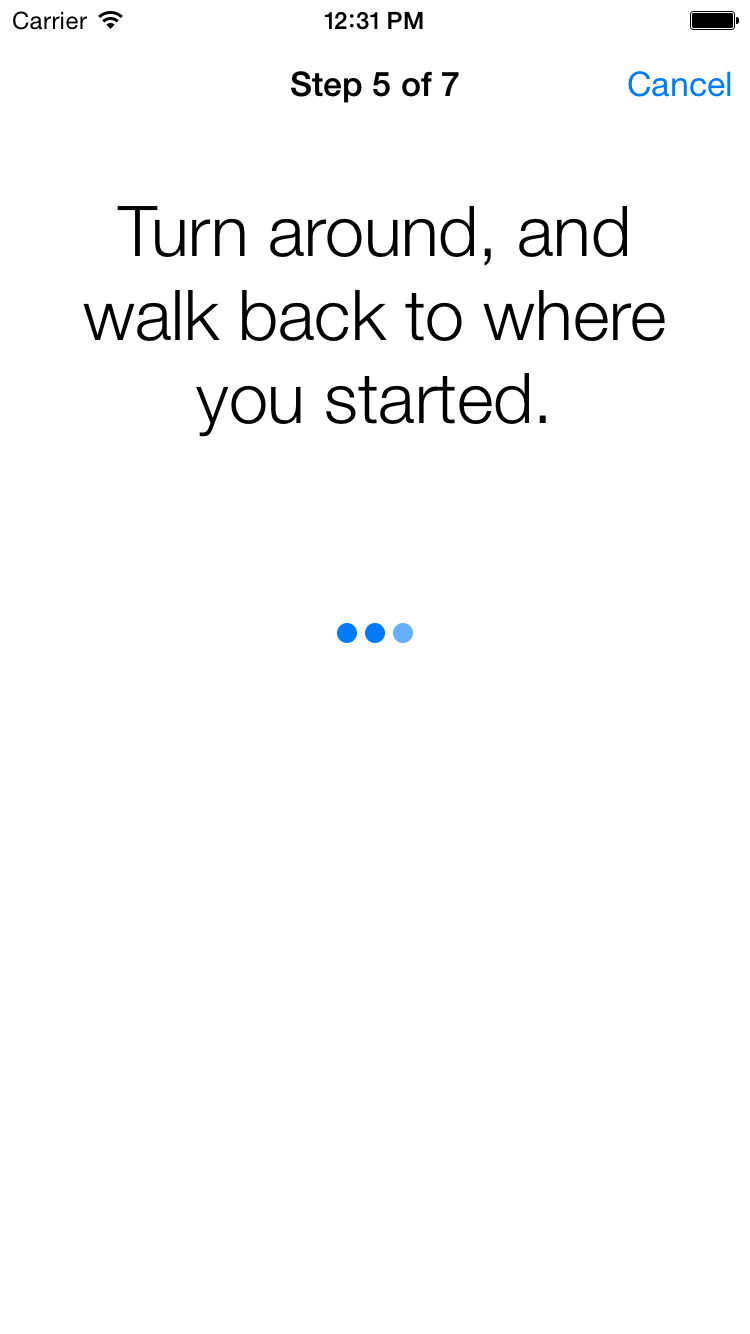
Asking user to walk
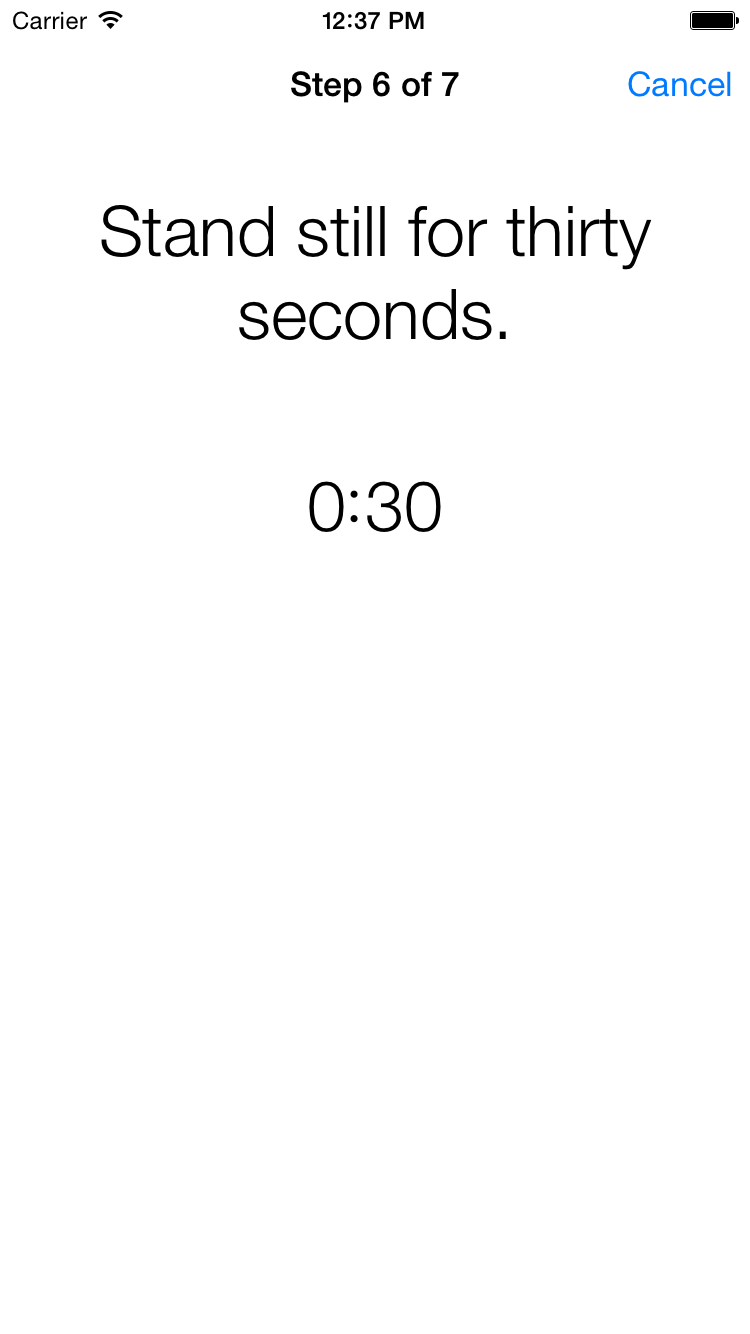
Asking user to rest
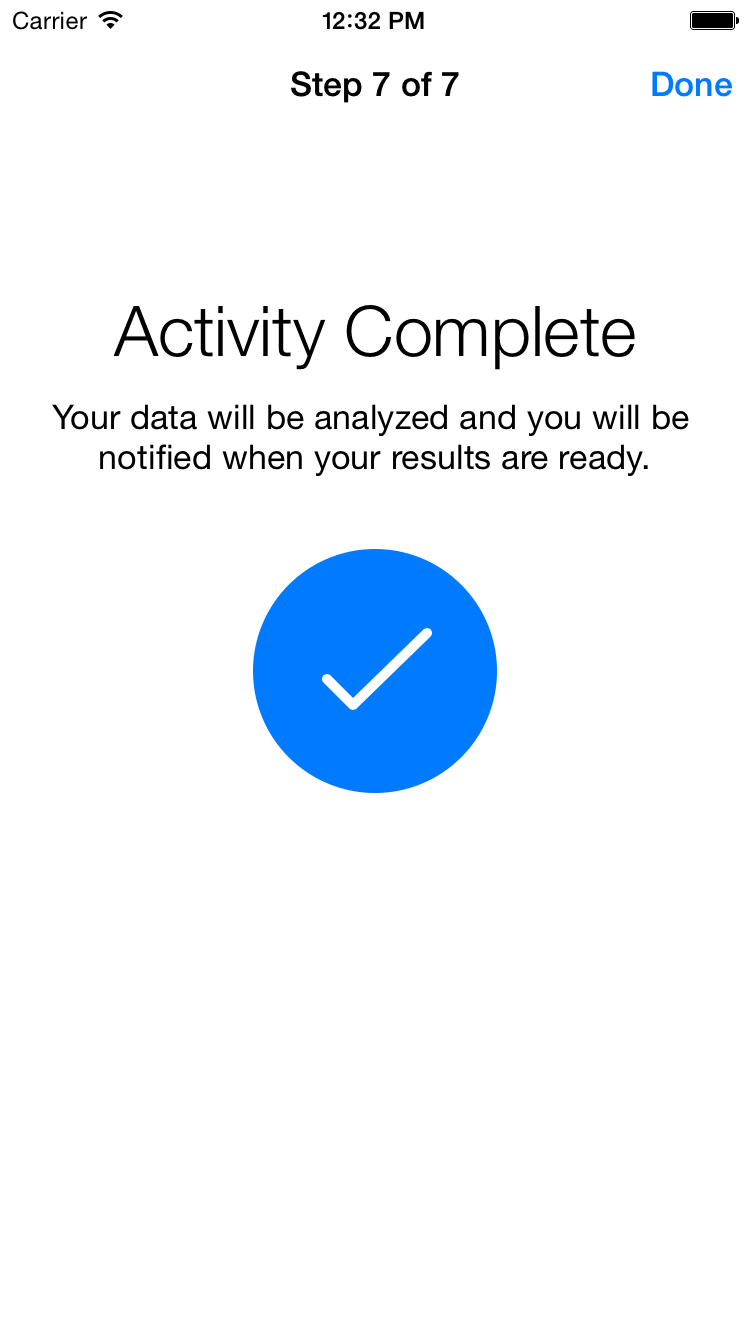
Completion Step
9-Hole Peg Test
The 9-hole peg test is a two step test of hand dexterity to measure the MSFC score in Multiple Sclerosis, Parkinson’s disease, or stroke.
Practically speaking, this task generates a two step test in which the participant must put a variable number of pegs in a hole (the place step), and then remove them (the remove step). This task tests both hands.
The data collected by this task includes the number of pegs, an array of move samples, and the total duration that the user spent taking the test.
Create 9-Hole Peg Test Task
Navigation: Axon > Studies > View Study > Create Task > Choose Predefined Active Task > Choose Peg in Hole
*Notes the field is required
| Field | Description | Data Format |
|---|---|---|
| Name* | Name of the Peg in Hole Task | Short Text |
| Code Name | Special internal code you can give to your task. It may reference an external system or an IRB Application number | Short Text |
| Description | Description of your task | Long Text |
| Dominant Left | The participant dominant hand that will be tested first. Checked means the left hand is first, unchecked means the right hand is first. | Checkbox |
| Number of Pegs* | The number of pegs to place in the pegboard. Number of pegs must be greater than or equal to 1 | Number |
| Time Limit | The duration allowed to validate the peg position. Duration can not be shorter than 1 seconds | Number |
| Threshold* | The threshold value used for the detection area. Must be greater than or equal to 0 and lower or equal to 1 | Number/Decimal |
| Rotated | Checking this will enable a test variant that also requires peg rotation | Checkbox |
The screenshots below show an example of both place and remove tasks.
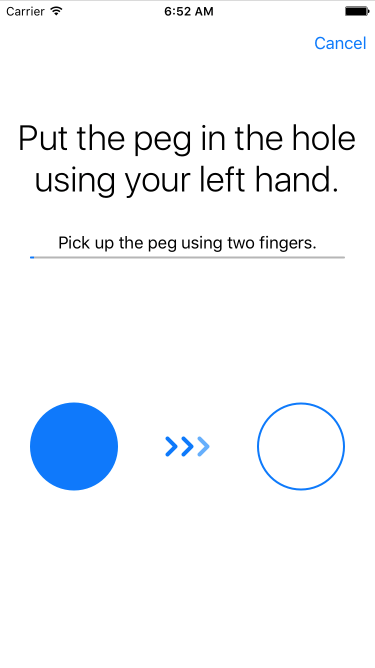
The peg place task
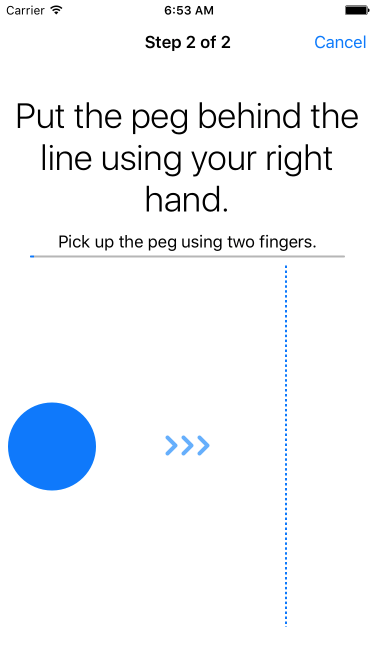
The peg remove step
Tower of Hanoi
In the Tower of Hanoi task, the user is asked to solve the classic Tower of Hanoi puzzle in a minimum number of moves. To solve the puzzle, the user must move the entire stack to the highlighted platform in as few moves as possible. This task measures the user’s problem solving skills. A Tower of Hanoi task finishes when the user completes the puzzle correctly or concedes that they cannot solve the puzzle.
Data collected in this task consists of how many moves were taken and whether the puzzle was successfully completed or not.
Create Tower of Hanoi
Navigation: Axon > Studies > View Study > Create Task > Choose Predefined Active Task > Choose Fitness Check
*Notes the field is required
| Field | Description | Data Format |
|---|---|---|
| Name* | Name of the Tower of Hanoi Task | Short Text |
| Code Name | Special internal code you can give to your task. It may reference an external system or an IRB Application number | Short Text |
| Description | Description of your task | Long Text |
| Number of Disks* | The number of disks in the puzzle; the default value for this property is 3 | Number |
The screenshots below show an example of a Tower of Hanoi task.
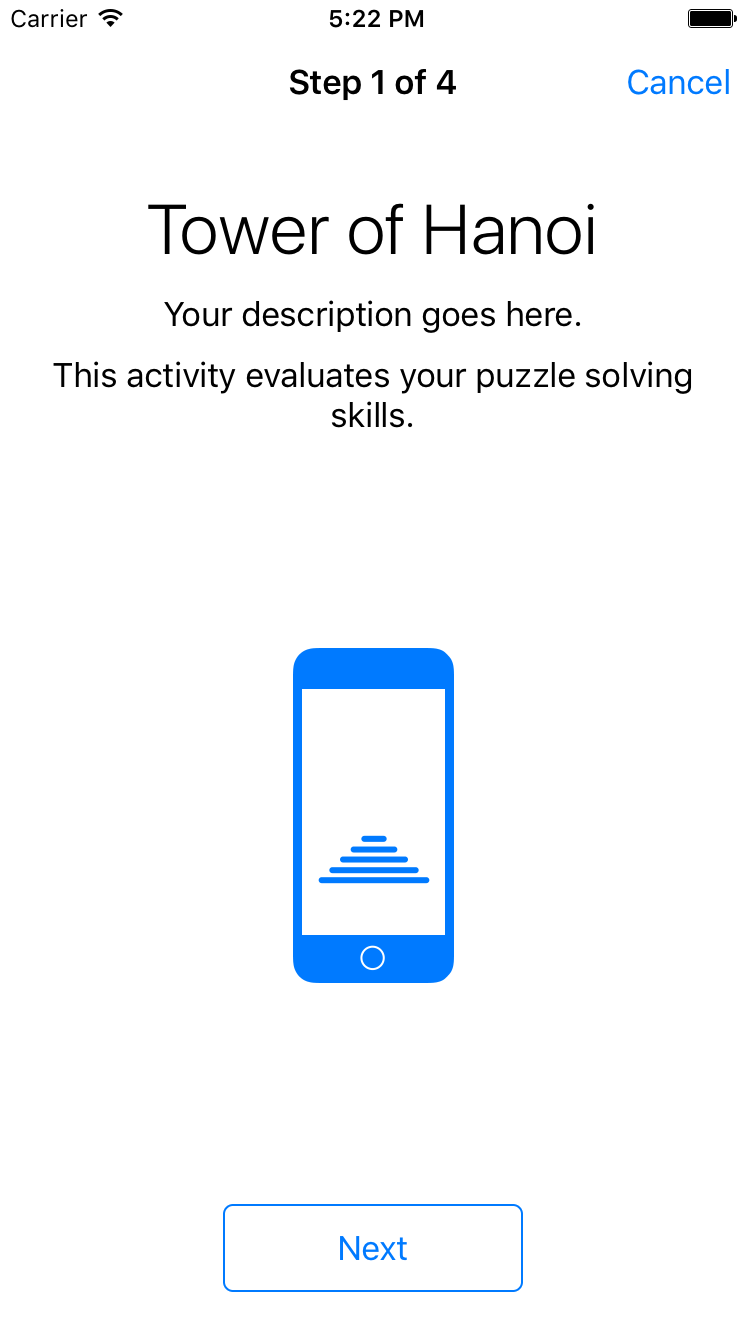
Instruction Step
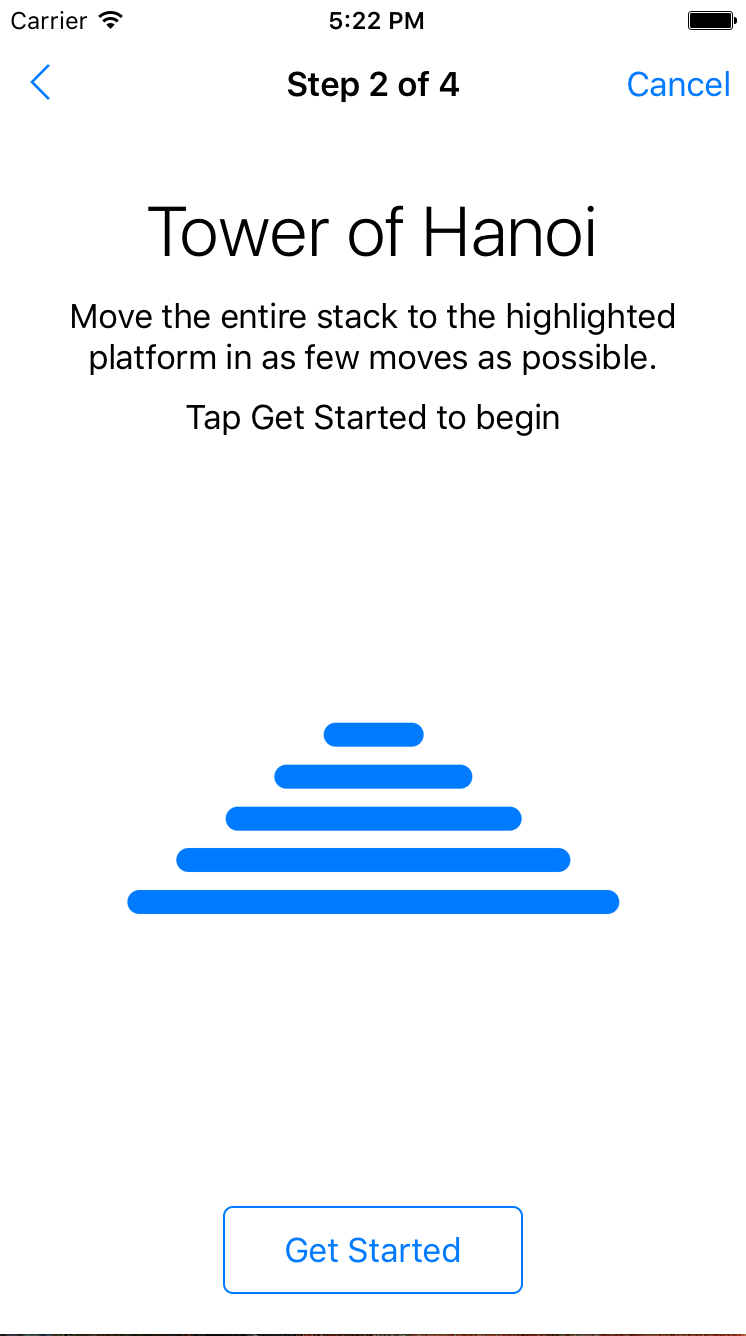
Instruction Step
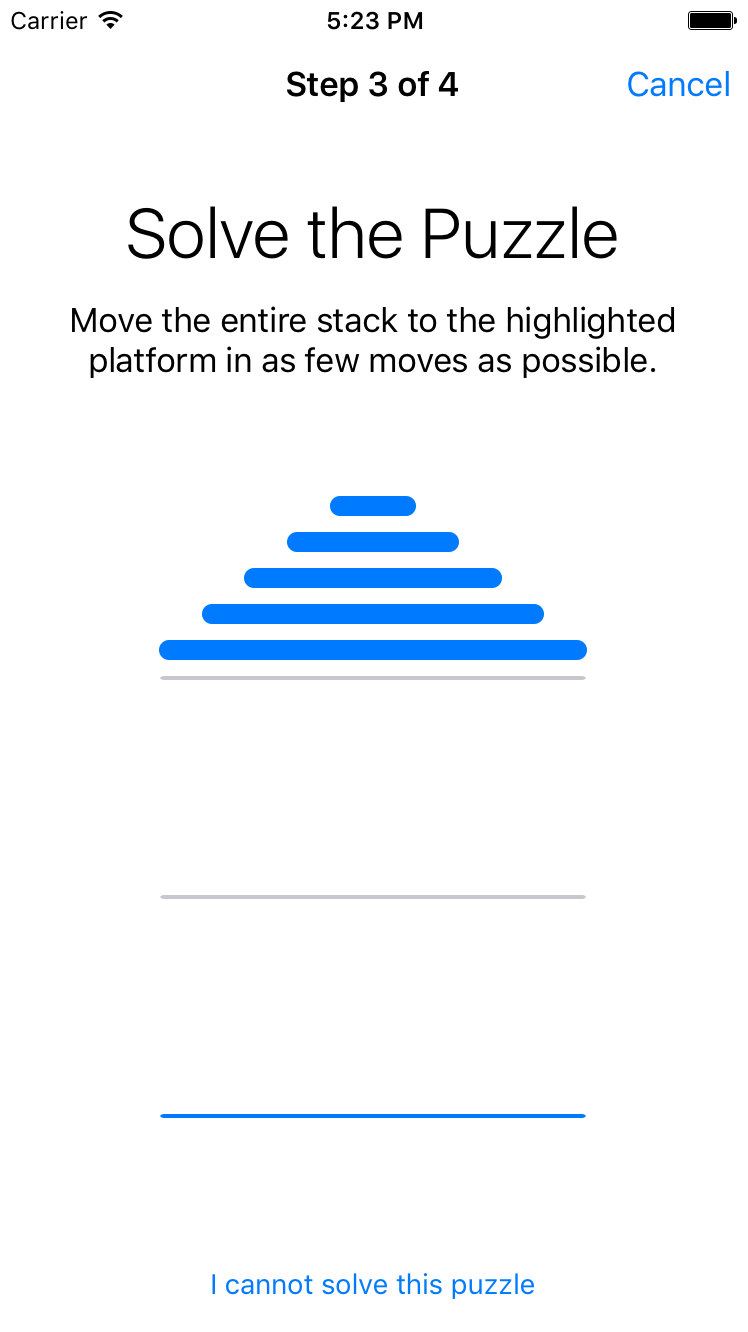
Actual Task
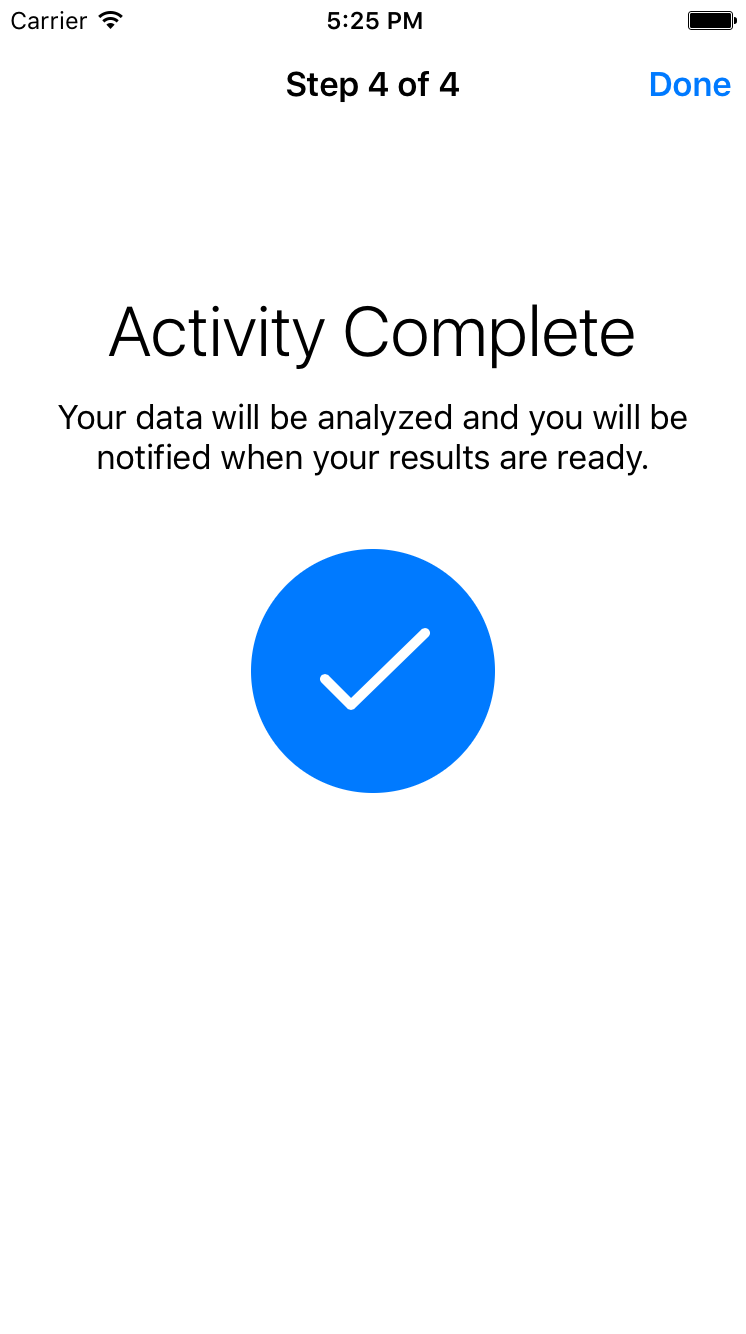
Completion Step
Updated 4 months ago